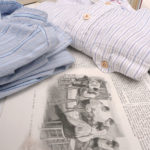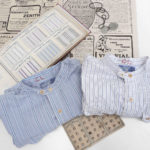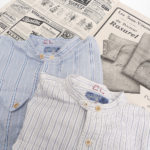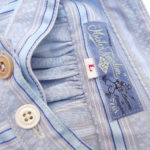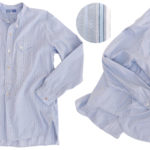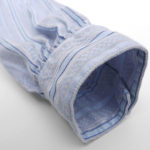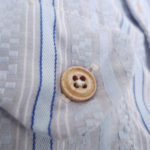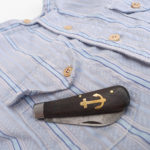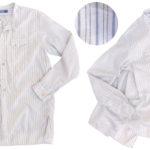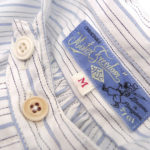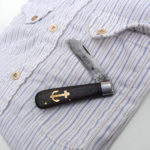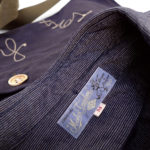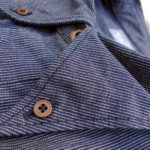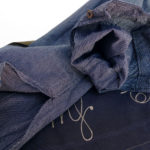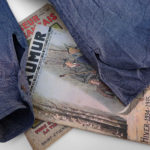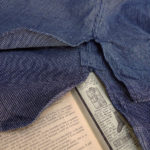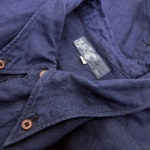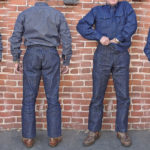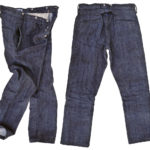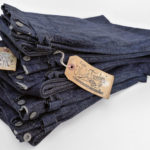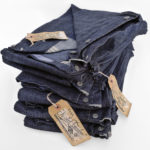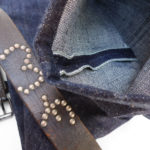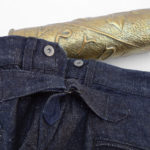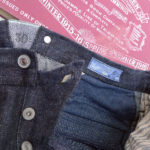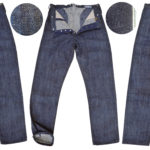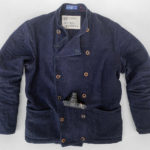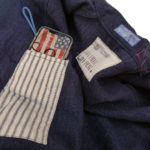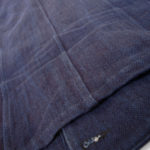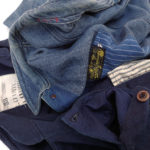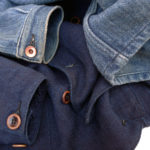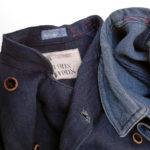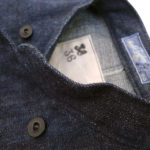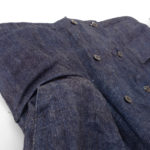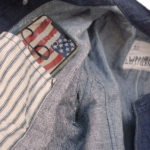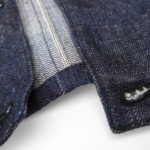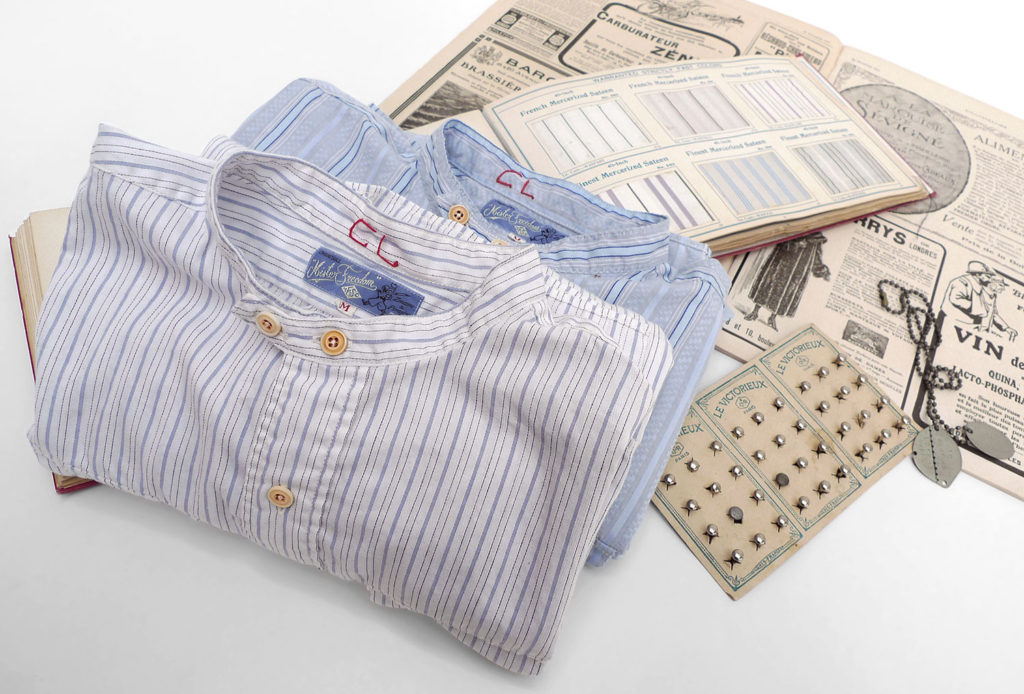
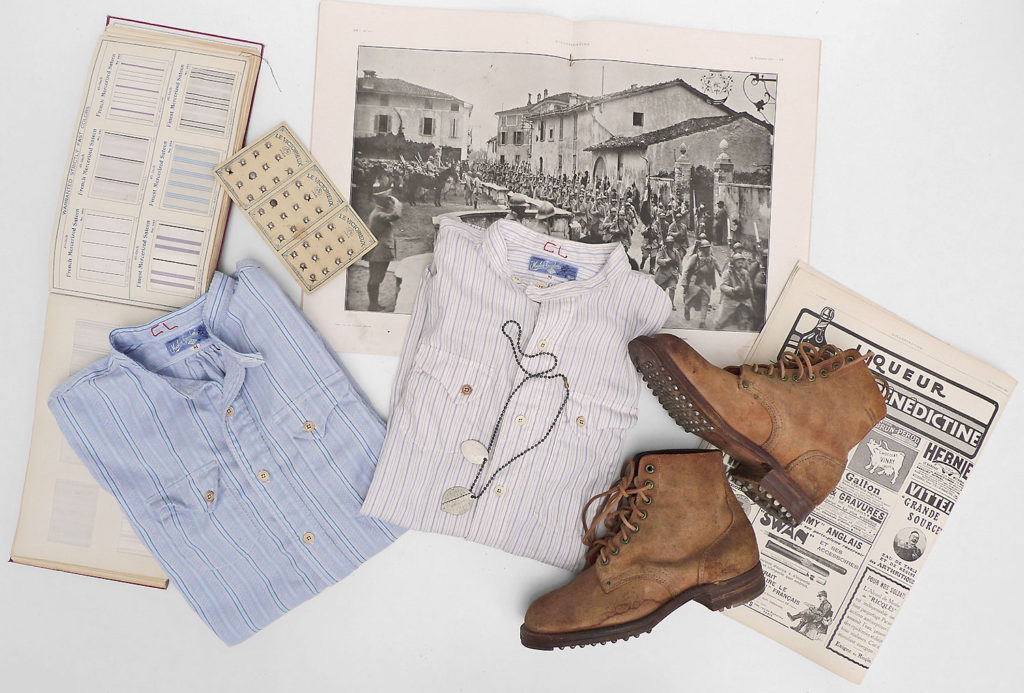
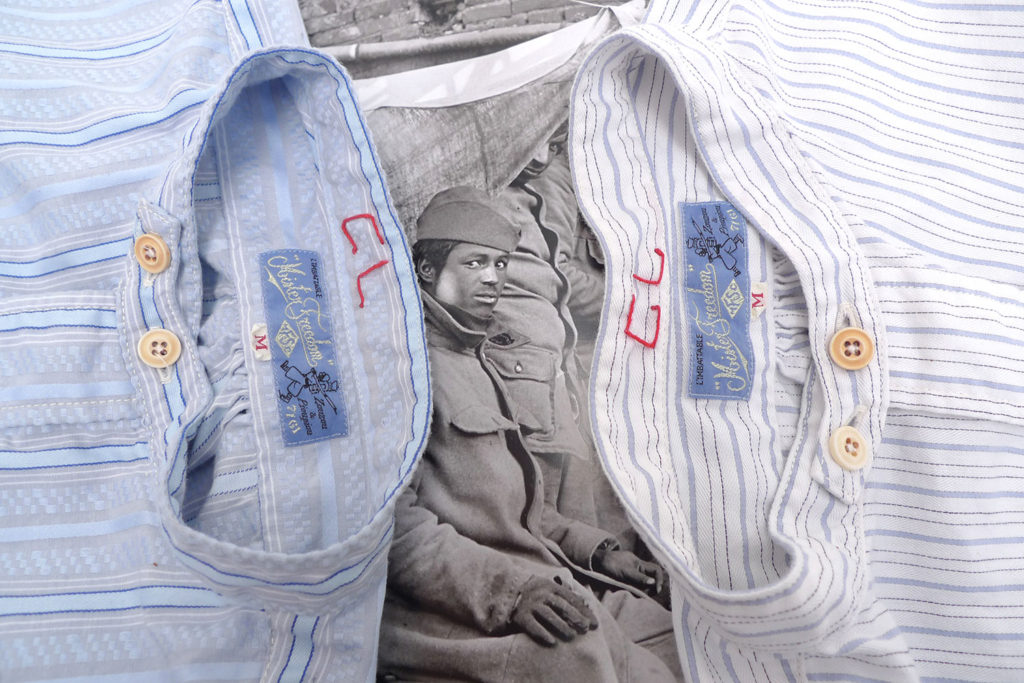
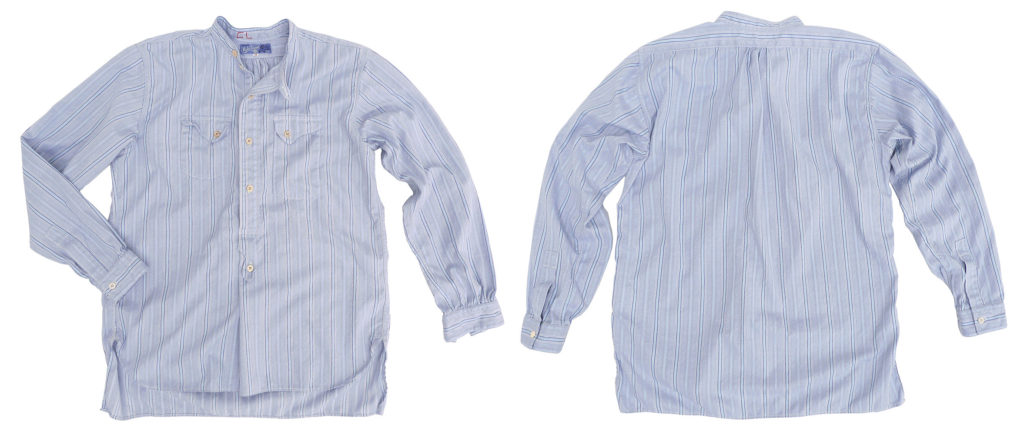
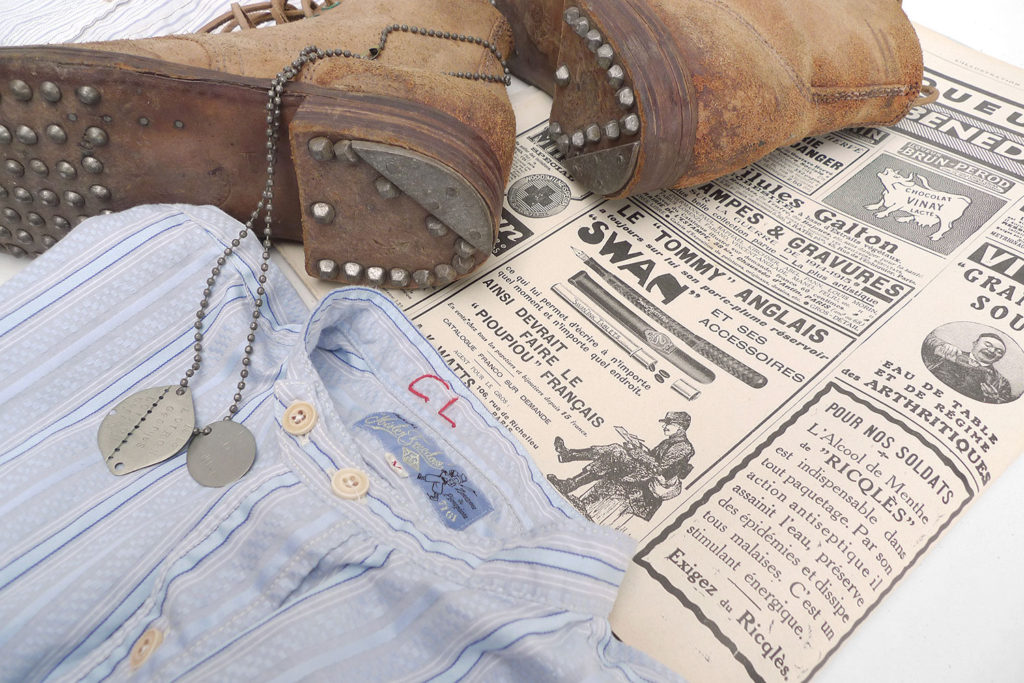

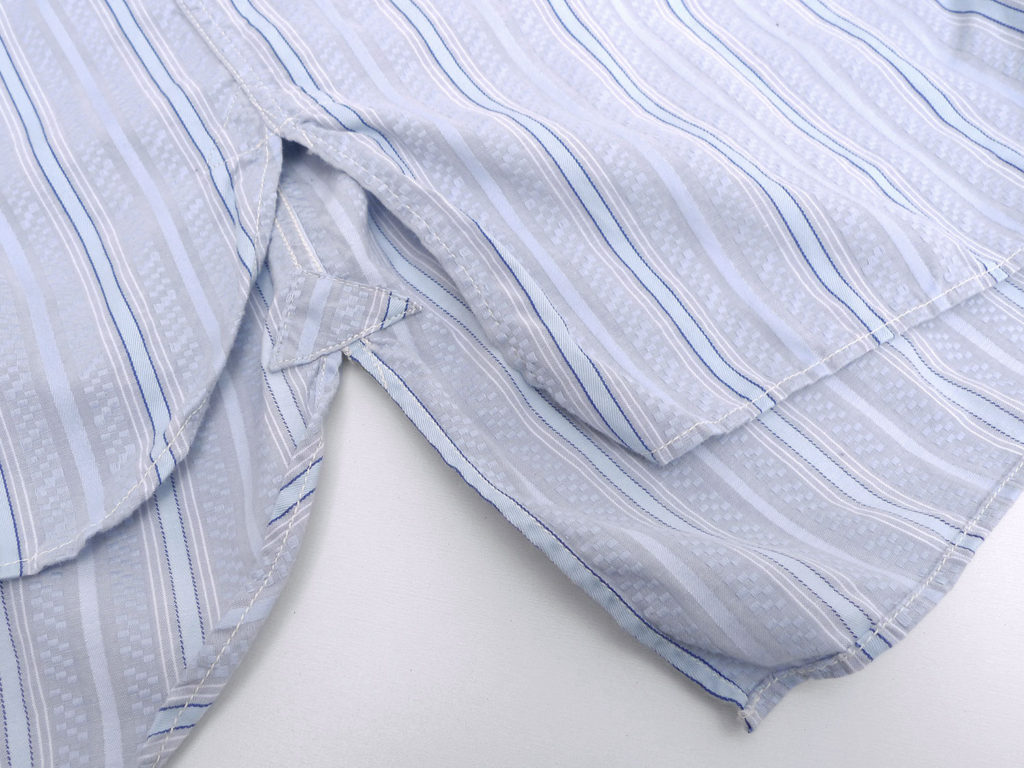
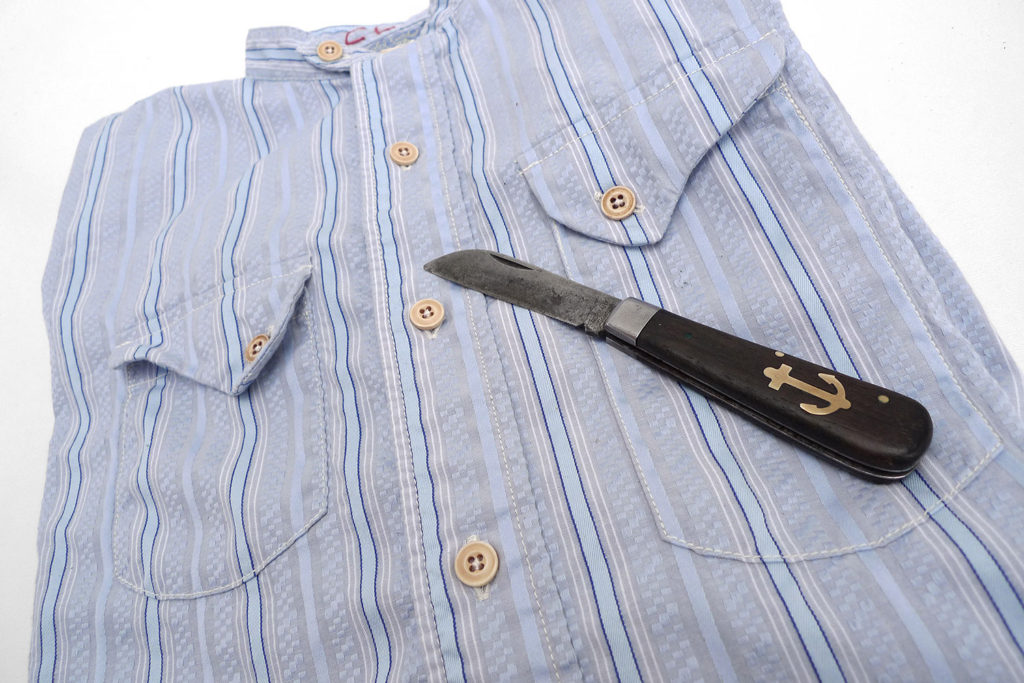
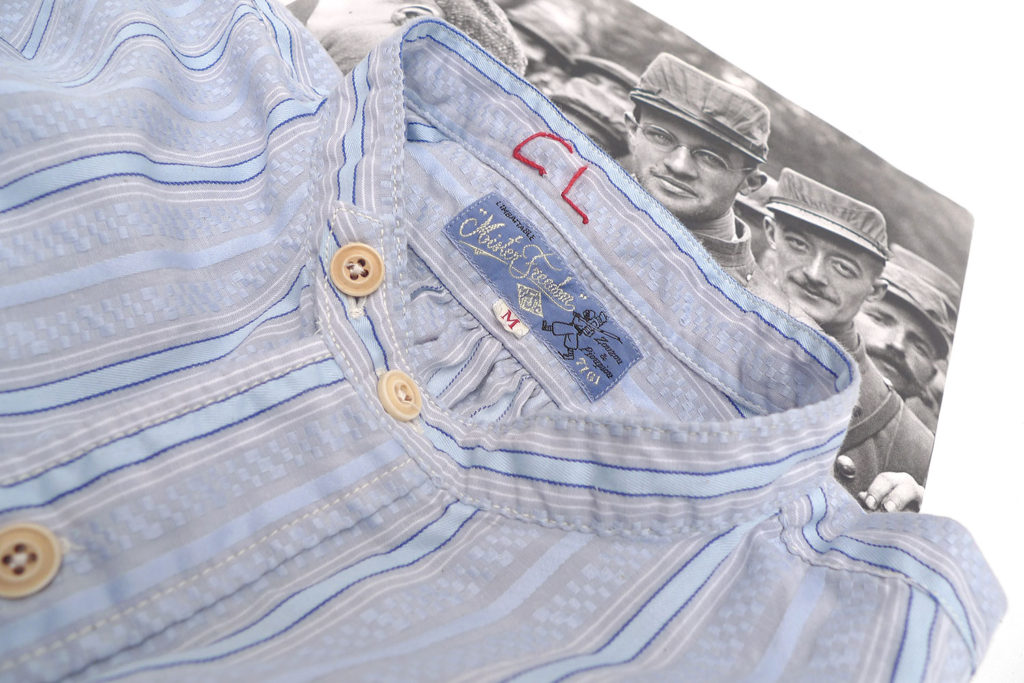
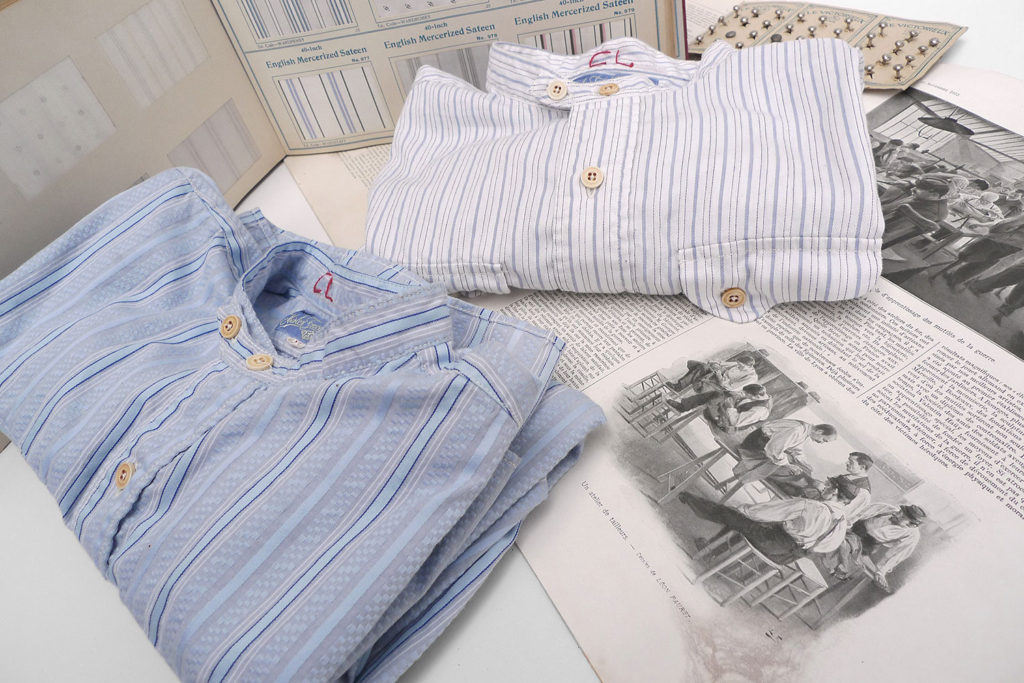
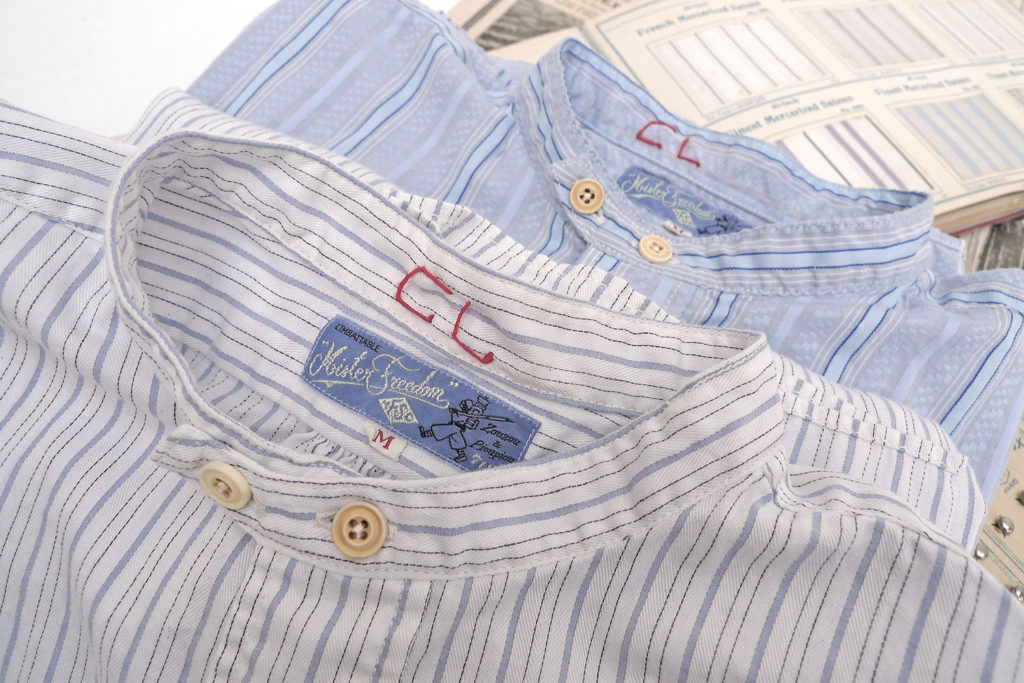
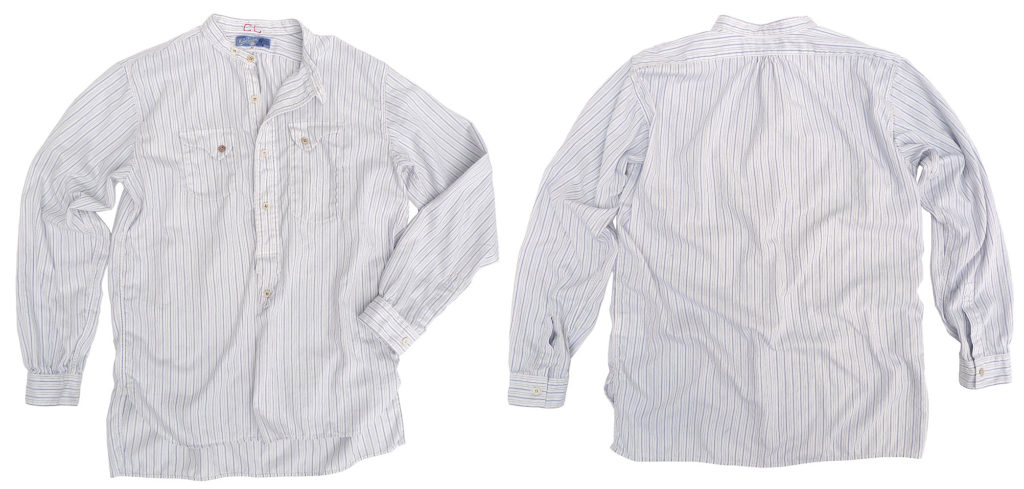
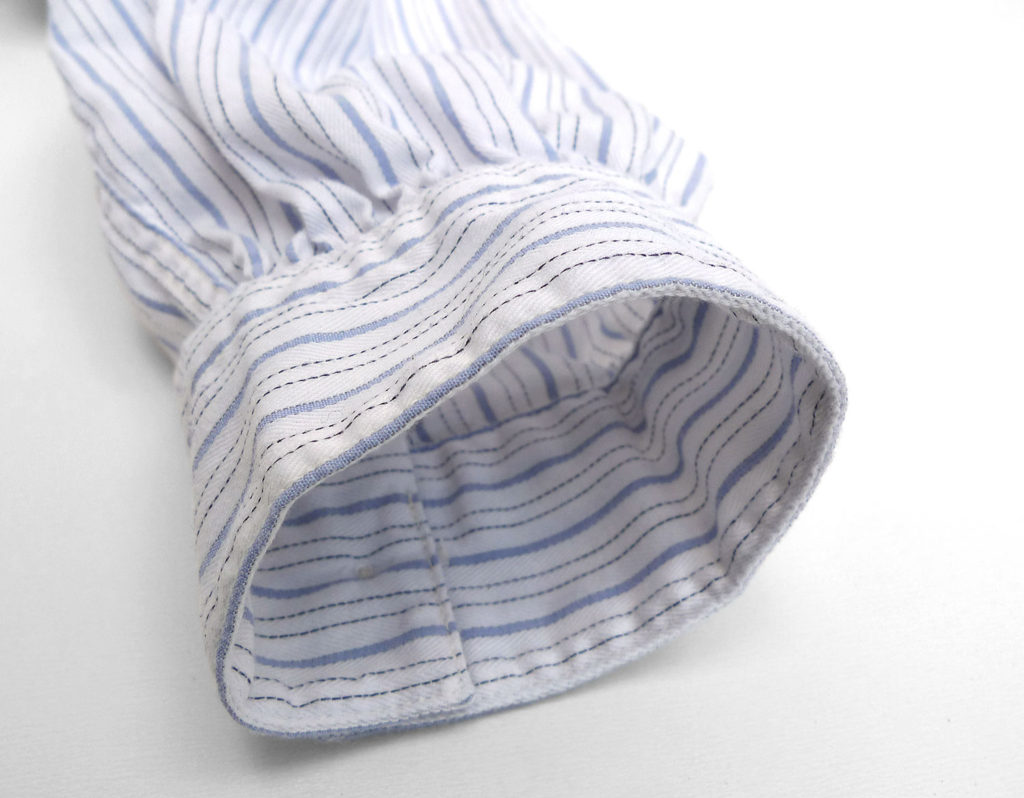
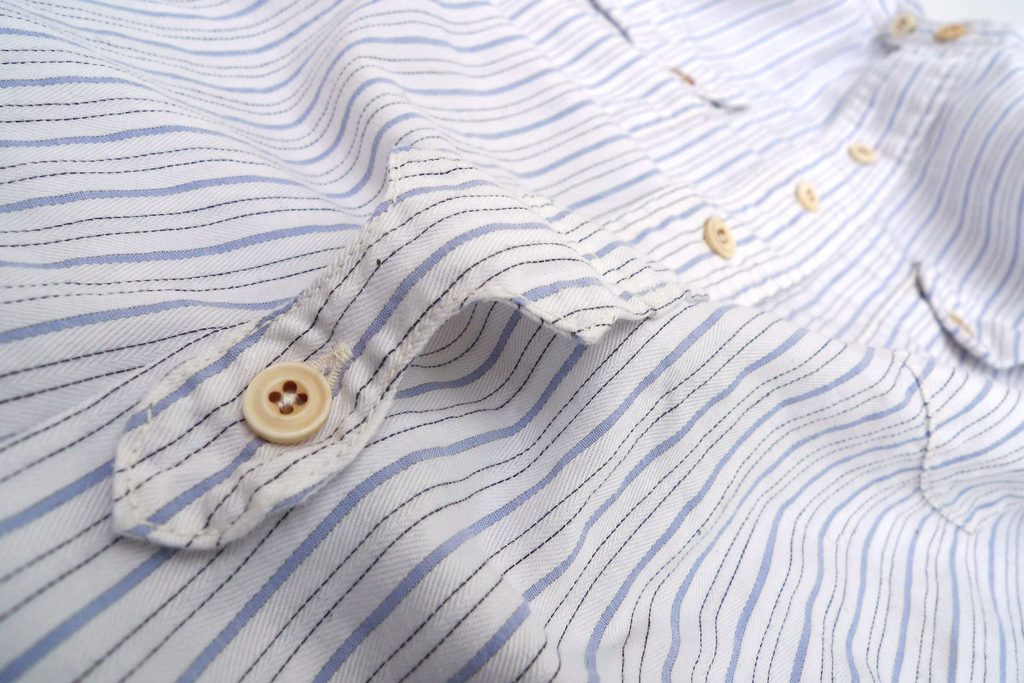
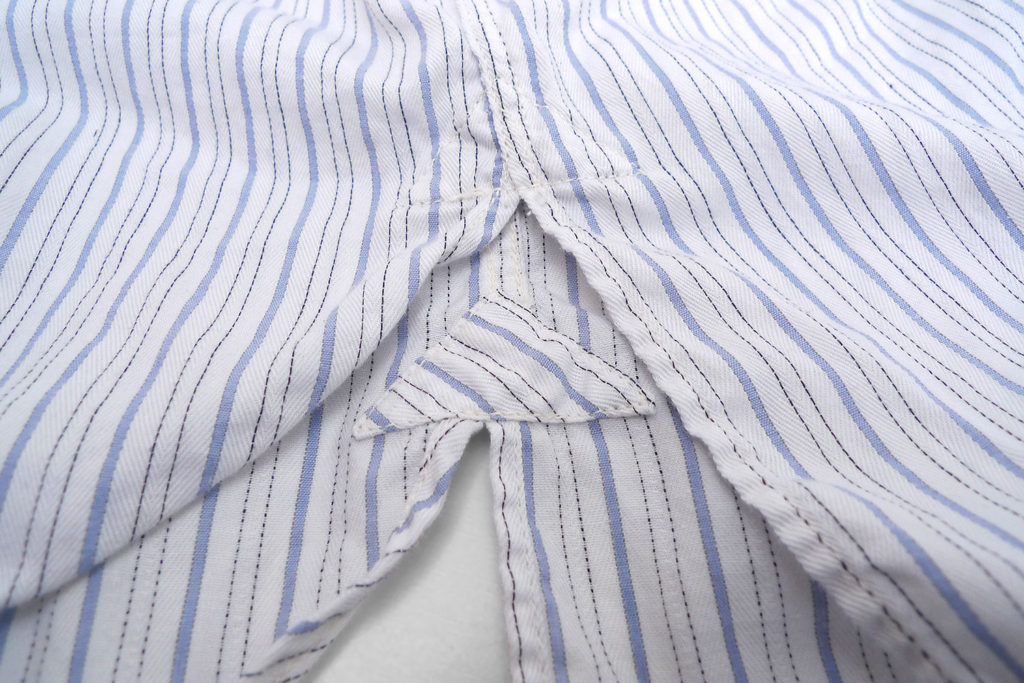
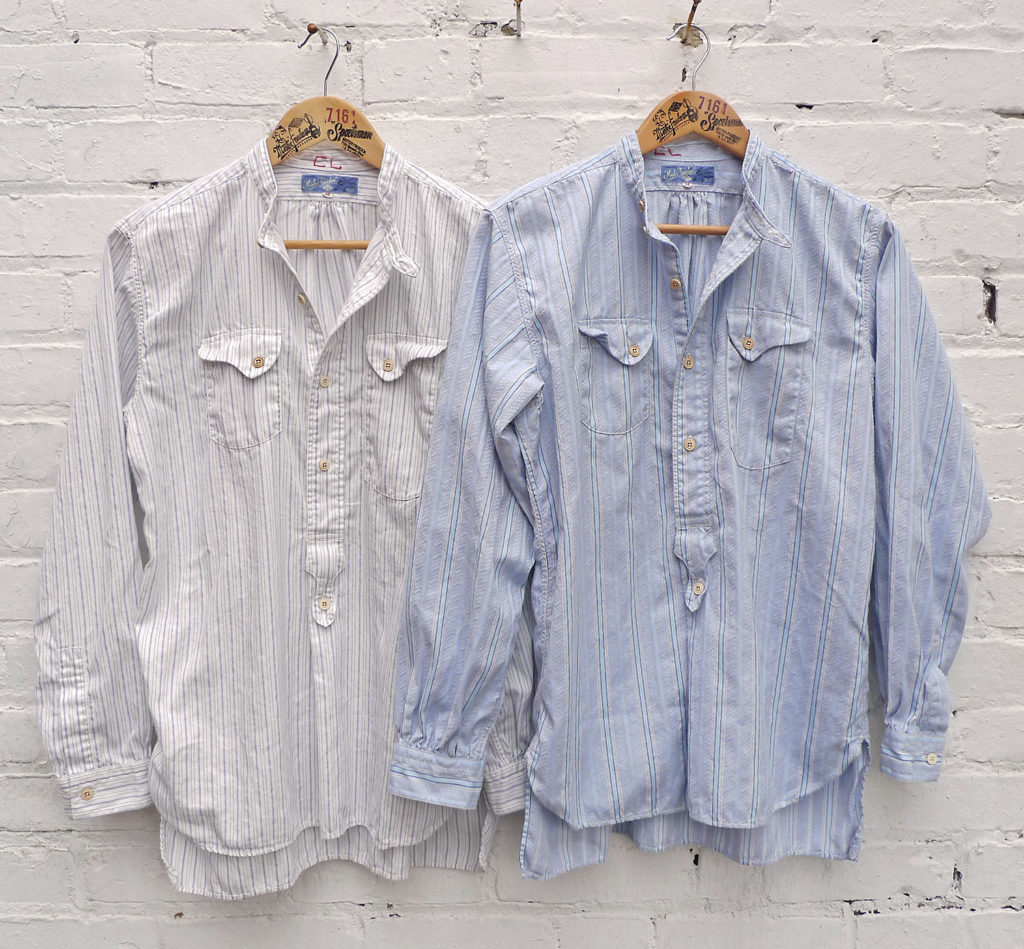
Mister Freedom® “Chemise Poilu”, Cotton Dobby Stripe.
FW2019 mfsc “PIOUPIOU” Collection.
Made in Japan.
The Mister Freedom® x Sugar Cane Co “Chemise Poilu” is the second shirting installment of the mfsc “PIOUPIOU” collection, a concept previously introduced in this post, loosely inspired by World events of the first half of the 20th Century.
The Grandfather of the M35 – the khaki uniform shirt issued to French troops in 1935 and the inspiration behind the MF® Liquette M35 – was a flannel pull-0ver collarless shirt introduced in 1878. Issued in stripe or small check patterns, that M1878 garment might seem like an odd choice for an official piece of WW1 uniform, even for the fashion-conscious French Army État Major! However, the civilian-looking shirt was concealed under a fully-buttoned tunic, and was only worn on the outside during rest periods, or chow time at camp.
When military tunics started featuring open collars the mid 1930s’s, the need for more ‘appropriate’ shirting became evident. In 1935, the M35 with its elegant and fashionable “Col Aiglon” was introduced, in a range of drab khaki colors. That specific Aiglon collar shape was a key design feature of our recently-released take on the M35, somehow demilitarized by our choice of fancy indigo linen and workwear stripe ticking fabrics.
The MF® interpretation of the M1878 is a departure from the vintage originals (see photo below of an authentic WW1 striped model and its characteristic period black ink chest marking), with their rudimentary pattern and tent-like dated fit. We actually pulled-out an old original mfsc pattern from the vaults for the body, the Chemise Hirondelle from our “Les Apaches” days of 2011. After tweaking pocketing and collar patterns, it morphed into a new shirt matching our Pioupiou story.
A key element was also the choice of fabric. We sourced out fancy shirting textiles from contemporary traditional bespoke tailoring catalogs and settled on two distinct cotton Dobby stripe fabrics. The white one is a striped combination of herringbone twill and sateen weave. The “Bleu Horizon” (sky blue) one is not a mere colored version of that, but a striped combo of sateen and poplin weave.
Interestingly, our fabrics are strikingly similar to vintage swatches included in a 1915-1916 supply catalog from the “BRÜNER WOOLEN Co, Importer and Manufacturers of Fine Tailors Trimmings”, preciously preserved in the MF® archives. The swatches are described as “French (and English) Mercerized Sateen”. The militaria collector will note that our pick of luxurious fabrics for the 2019 MF® Chemise Poilu is quite the departure from the utilitarian striped/checkered twills of authentic M1878 shirts, but you get the drift.
-
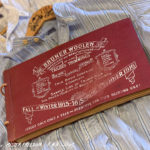
-
Vintage 1915-1916 Tailoring Trims catalog.
-
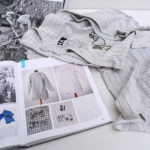
-
Original vintage WW1 French Army shirt with typical chest ink marking.
-
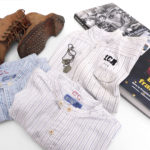
-
An authentic circa 1916 Poilu shirt, and our 2019 interpretation.
-
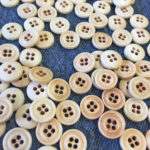
-
Genuine bone buttons for the MF® FW2019 Chemise Poilu..
Shirring on the cuffs and back yoke also add a touch of fancy tailoring. Genuine bone button with subtle variations in color are an extra vintage reference to 1900’s shirting.
We adapted the collar of our 2011 Hirondelle to a stand collar band type, and revisited the pocket shapes to accommodate a mobile phone, more popular today than pocket watches. The curvy and mirrored pocket flap shape dates back to when we were getting quite creative with them!
The characteristic ‘dangling’ cloth tab at the bottom of the button placket was initially conceived to fasten to one’s breeches waist button in the old days, to guarantee shirts stay tucked-in. We kept the nod to the 1910’s-30’s, but added a button to secure the tab on the shirt, understanding this was a 100 year-old obsolete feature. Get creative and submit a potential use for that tab to the HQ, for a chance to be featured on the MF® store IG feed!
This release wraps the Mister Freedom® x Sugar Cane Co FW2019 mfsc “PIOUPIOU” epic collection.
The MF® Chemise POILU is designed in California by Mister Freedom® and manufactured in Japan by Sugar Cane Co.
For in-depth research on WW1 French uniforms, we recommend “L’Armée Française dans la Première Guerre Mondiale” (ISBN 10: 3902526106) from this publisher, and publications from Histoires & Collections.
SPECS:
PATTERN:
An original mfsc pattern inspired by vintage French military uniform shirts, Old World fancy tailoring and early utilitarian shirting.
FABRICS:
Two distinct cotton Dobby stripe option:
a) White: Fine 100% cotton, white background with woven blue and black pinstripe, alternating herringbone twill and sateen weave.
b) Blue: Fine 100% cotton, “Bleu Horizon” (sky blue) background with woven blue and navy stripes, alternating poplin and sateen weave.
DETAILS:
* Pull-over type, with front expansion pleat.
* Stand collar with chin strap.
* Genuine bone buttons, with subtle variations in natural colors.
* Original mfsc pocket shapes and flaps.
* Unbalanced chest pocketing. Elongated right pocket fits average mobile phone.
* Tab on button placket to secure to breeches’ waist button.
* Cuffs and back yoke shirring.
* Contrasting shirt tails, longer in back and rounded in front.
* Inside triangular side gusset reinforcement patches.
* Original mfsc “Pioupiou” woven rayon label.
* Made in Japan.
SIZING/FIT:
Both fabric options of the MF® Chemise POILU come raw/un-rinsed.
We recommend the usual protocol for cotton shirts before wearing:
* Cold soak for about 30-40mn, with occasional hand agitation.
* Spin dry and line dry.
Both versions will fit the same following the above procedure. I am usually a Medium (15½) in mfsc shirting, and I opted for a Medium in both fabric options, for a comfortable somewhat ‘period’ fit with a ‘vintage’ silhouette partly due to the extended rear shirt tail.
Extra (quite attractive) seam puckering will happen if using a heat dryer (on low), and will also result in extra (minimal) shrinkage as the seams pull.
We recommend getting your usual mfsc shirt size, but please refer to sizing chart for measurements, reflecting a 30-40mn cold soak/spin dry/line dry process. The raw measurements are given for reference only, as the numbers that actually matter are post soak. We do believe that, according to frequency of use, washable garments should be laundered when needed, and not kept ‘raw’.
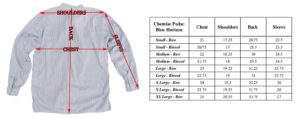 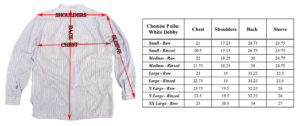
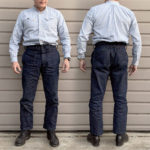
CARE:
Launder when needed. Machine wash on gentle cycle, cold water, minimum eco-friendly mild detergent and line dry.
Available RAW/unwashed.
SIZES:
14½ (Small)
15½ (Medium)
16½ (Large)
17½ (X-Large)
18½ (XX-Large)
Available from our Los Angeles red brick HQ, from www.misterfreedom.com, and fine retailers around the World.
Email sales@misterfreedom.com or call 323-653-2014 with any questions unanswered above.
Thank you for your support,
Christophe Loiron
Mister Freedom®
©2019
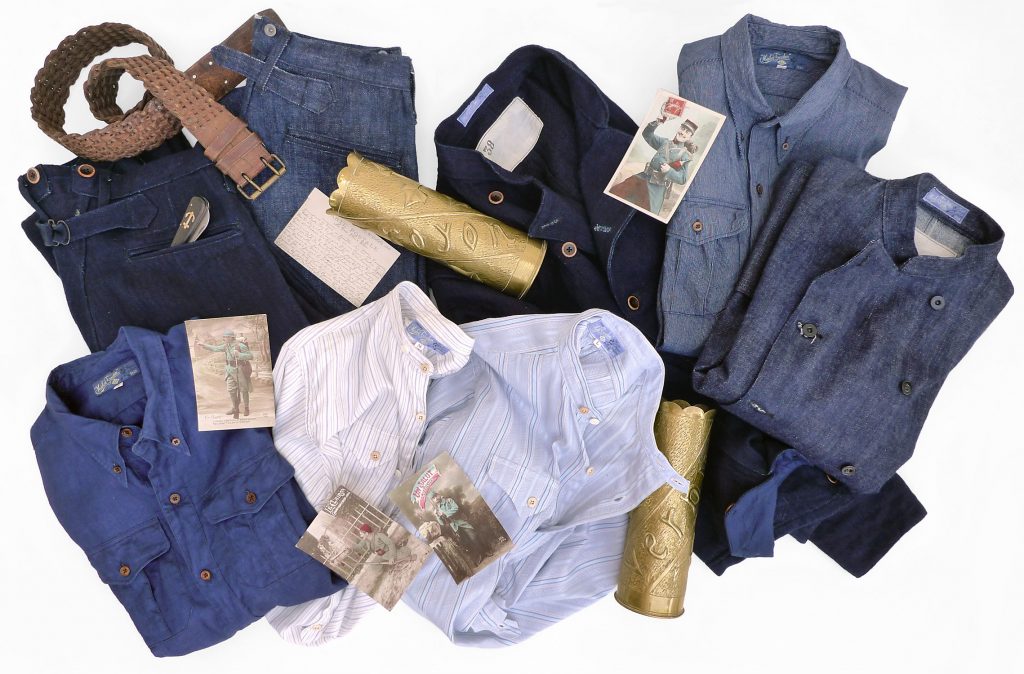
Mister Freedom® FW2019 mfsc Liquette M35: Indigo Pin Stripe Ticking model.

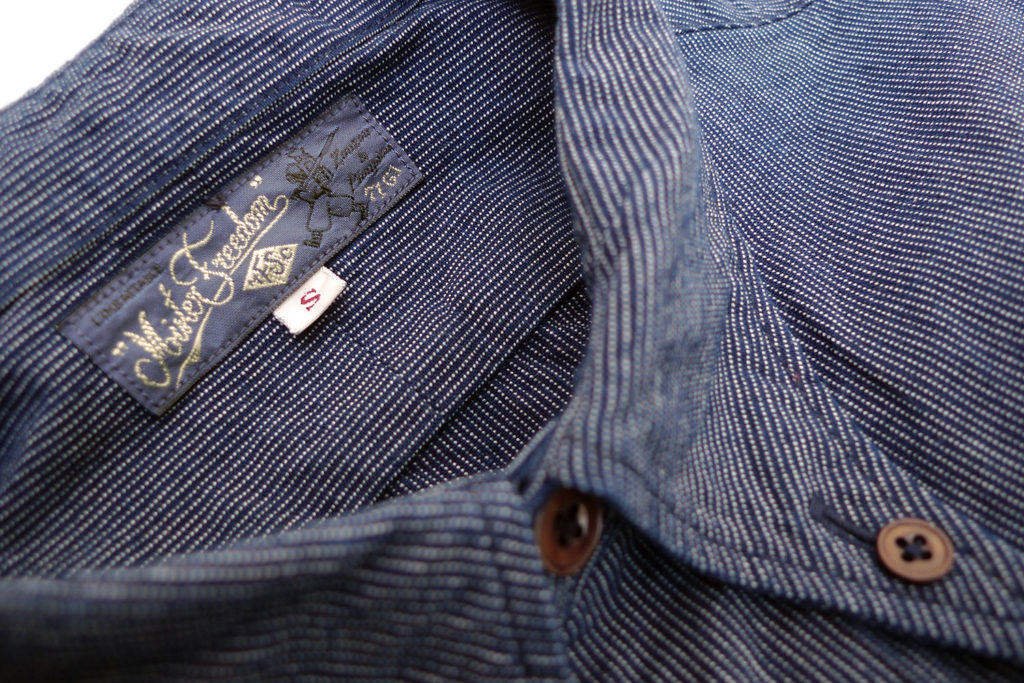
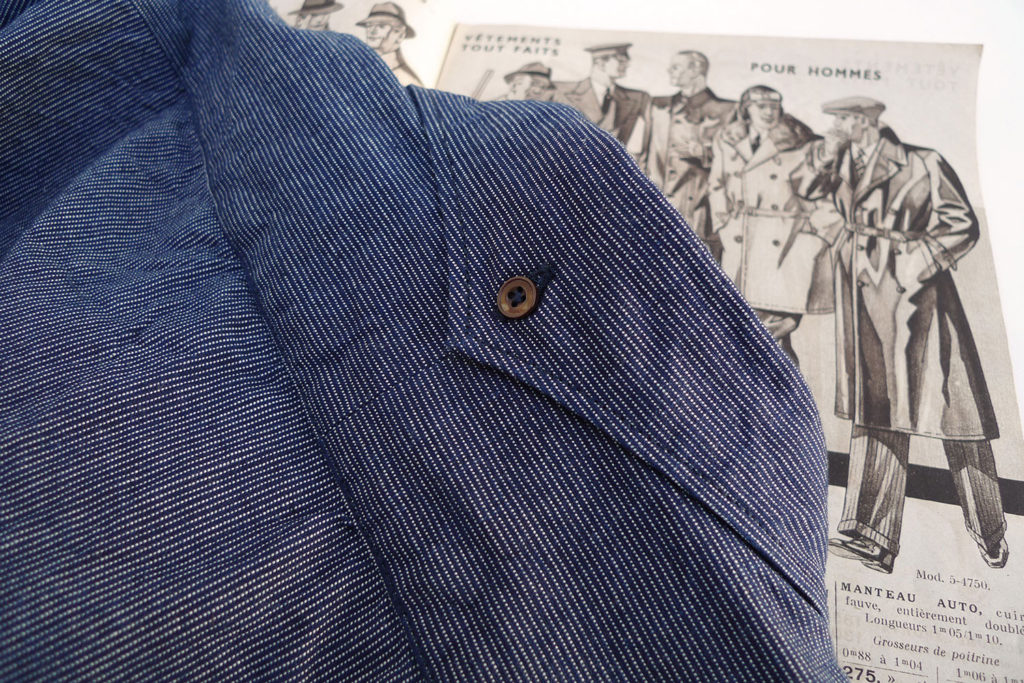
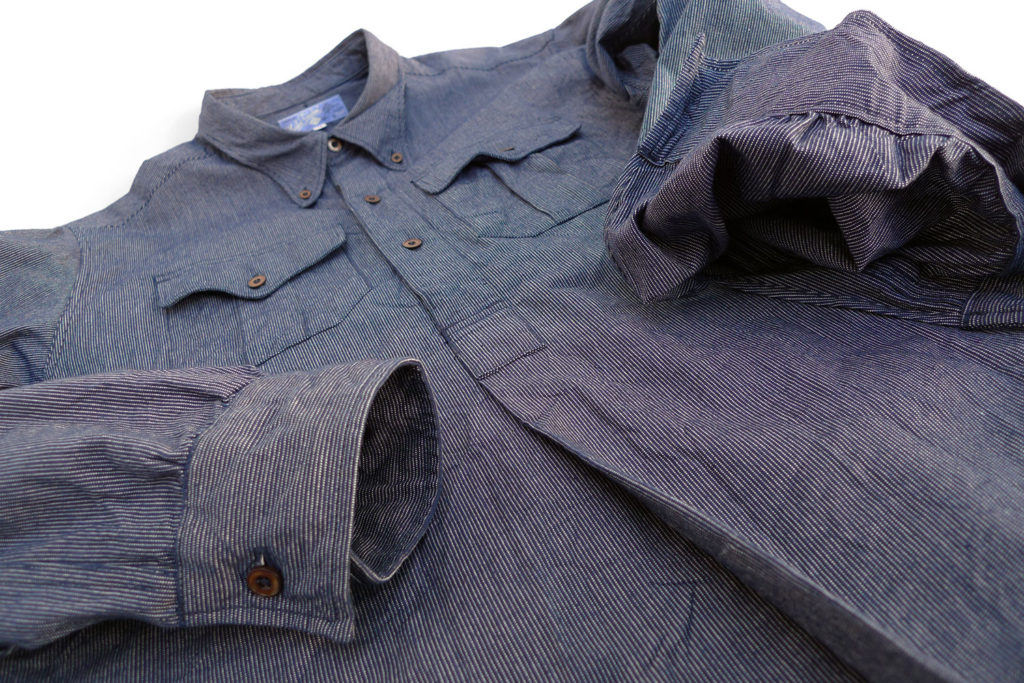
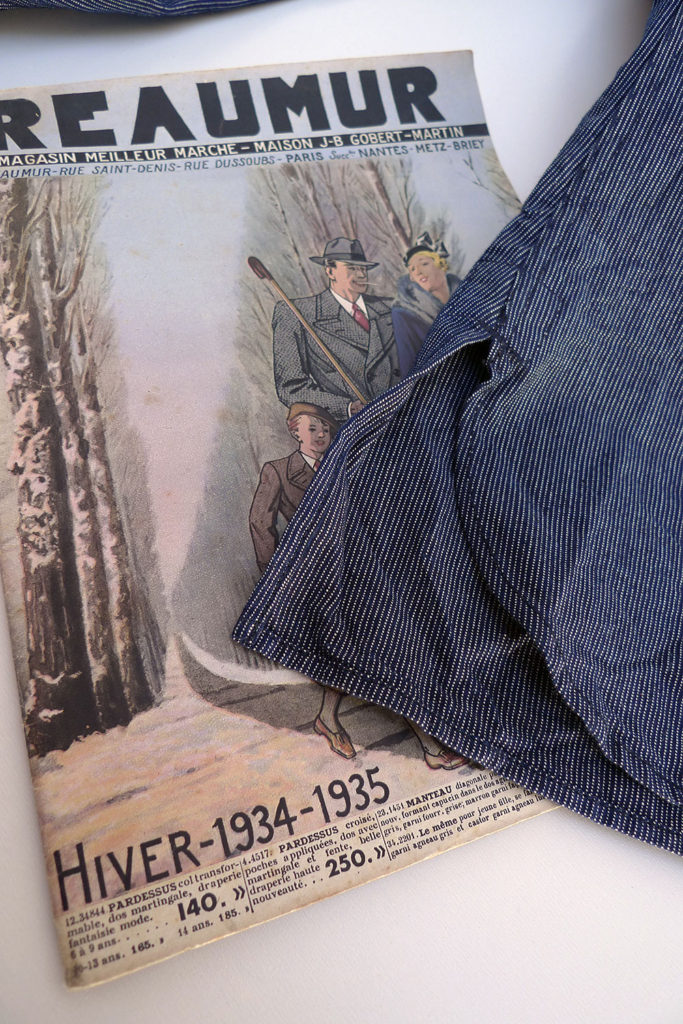
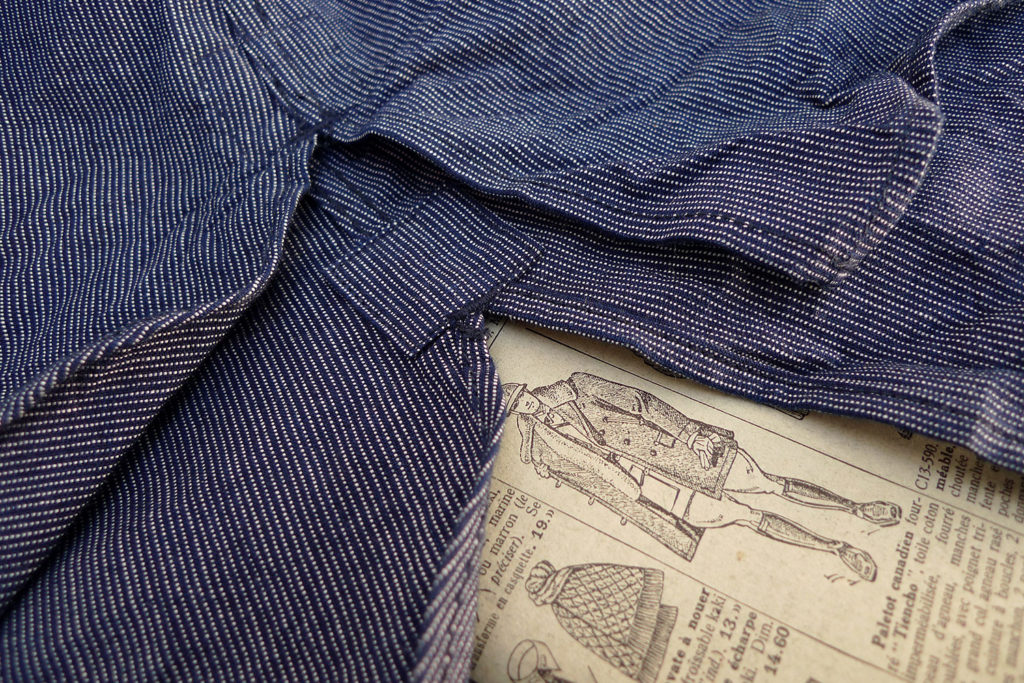
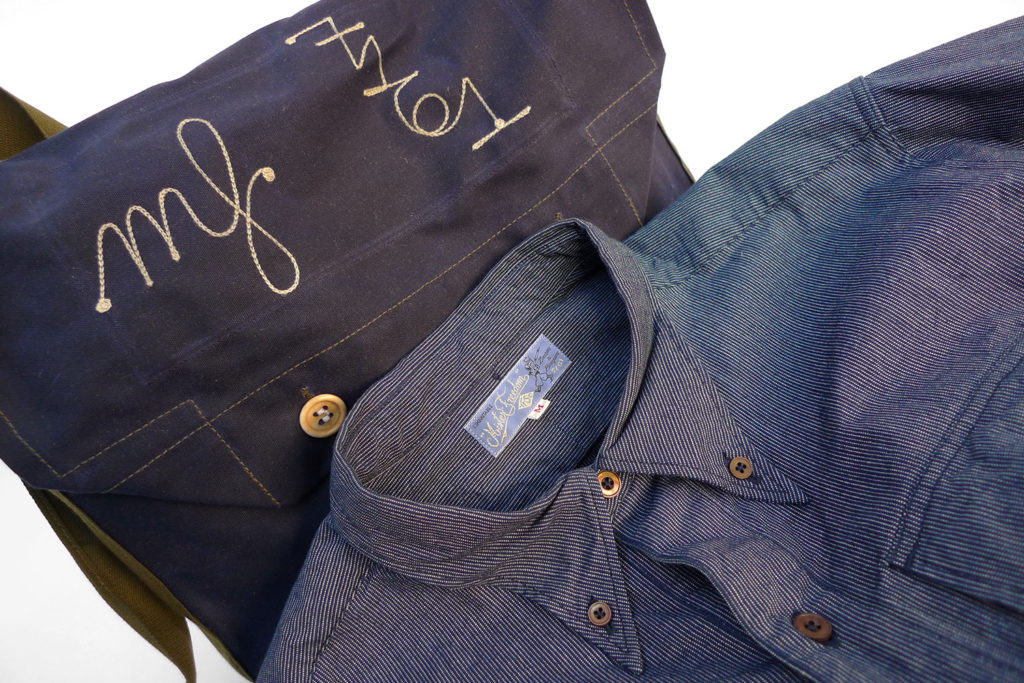
Mister Freedom® FW2019 mfsc Liquette M35: Indigo Linen model.
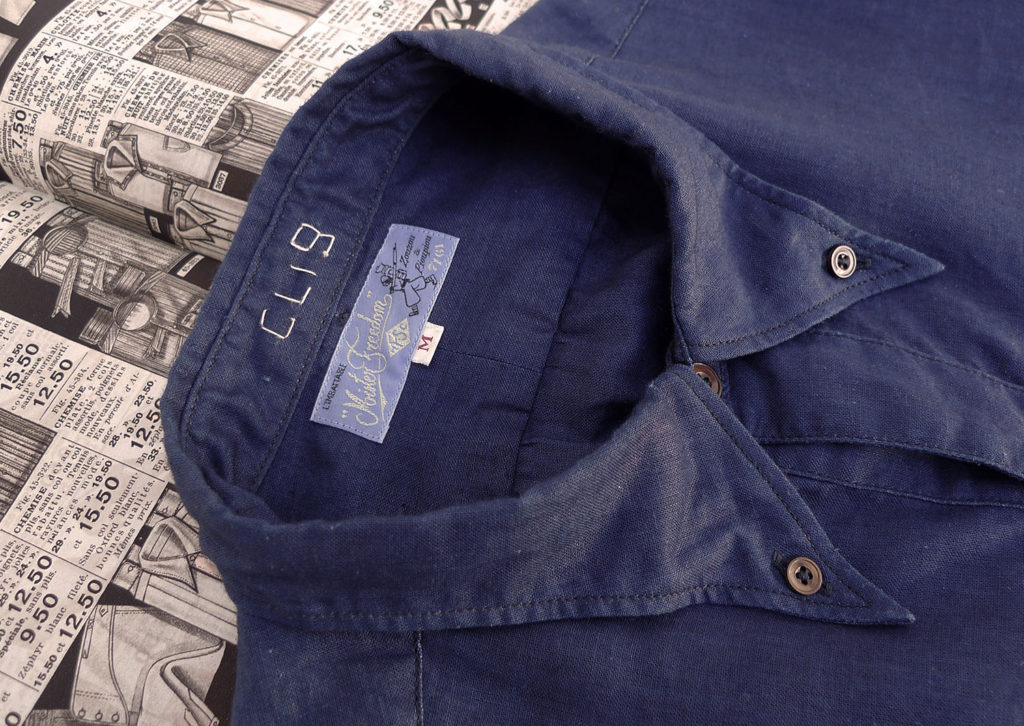
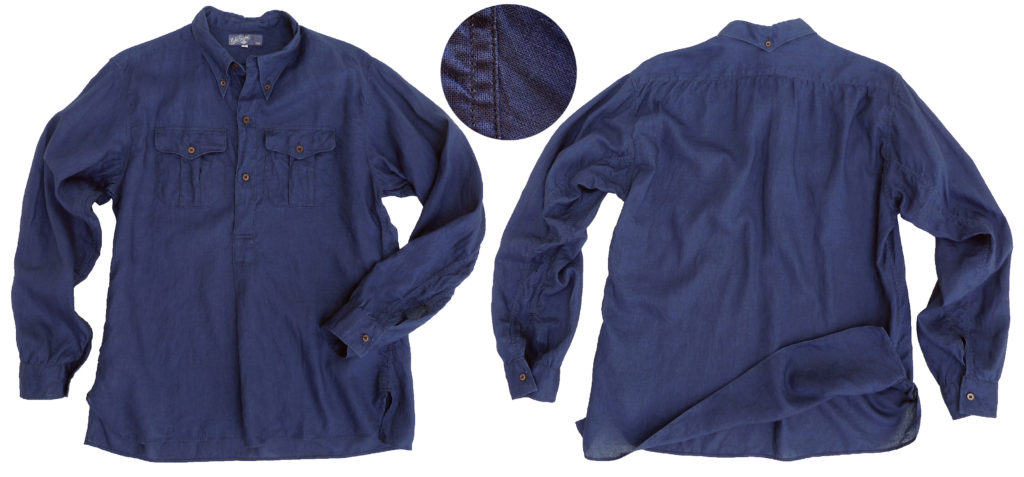
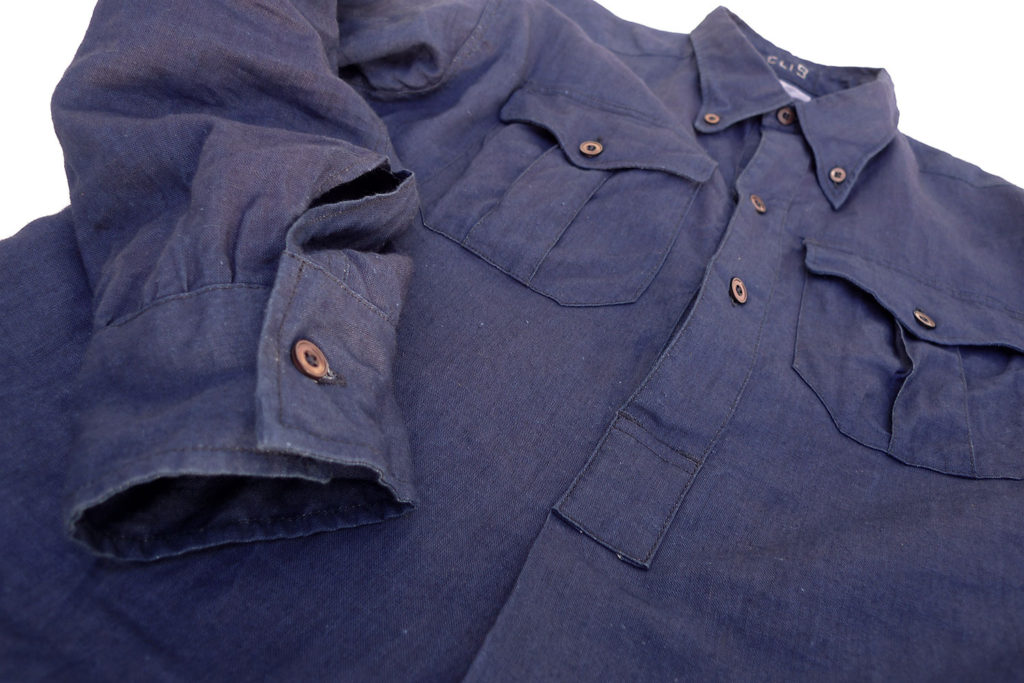

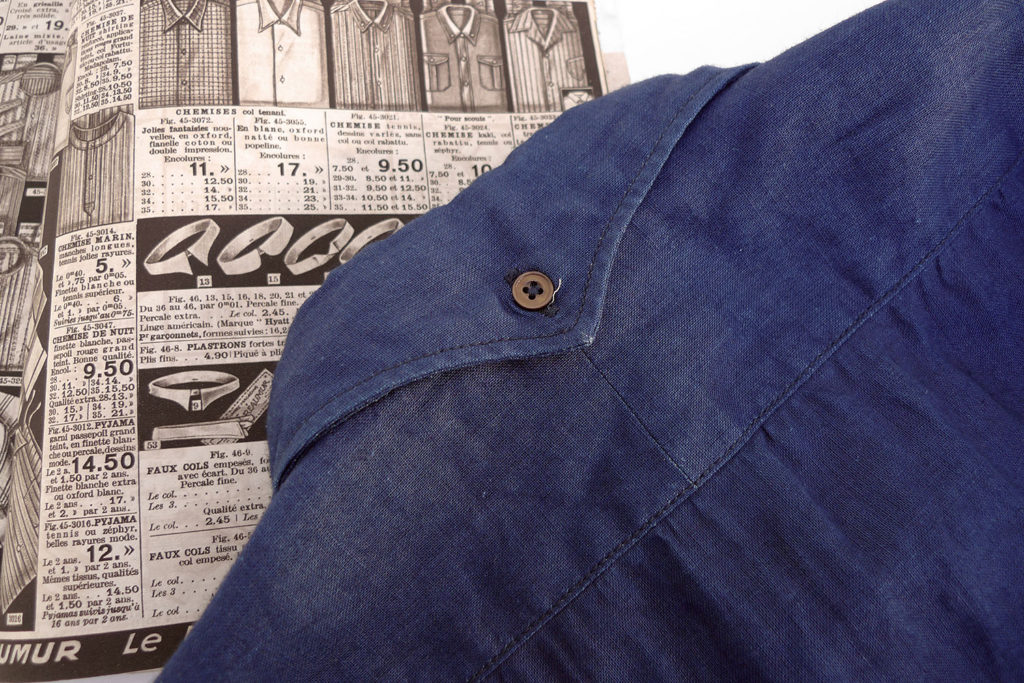
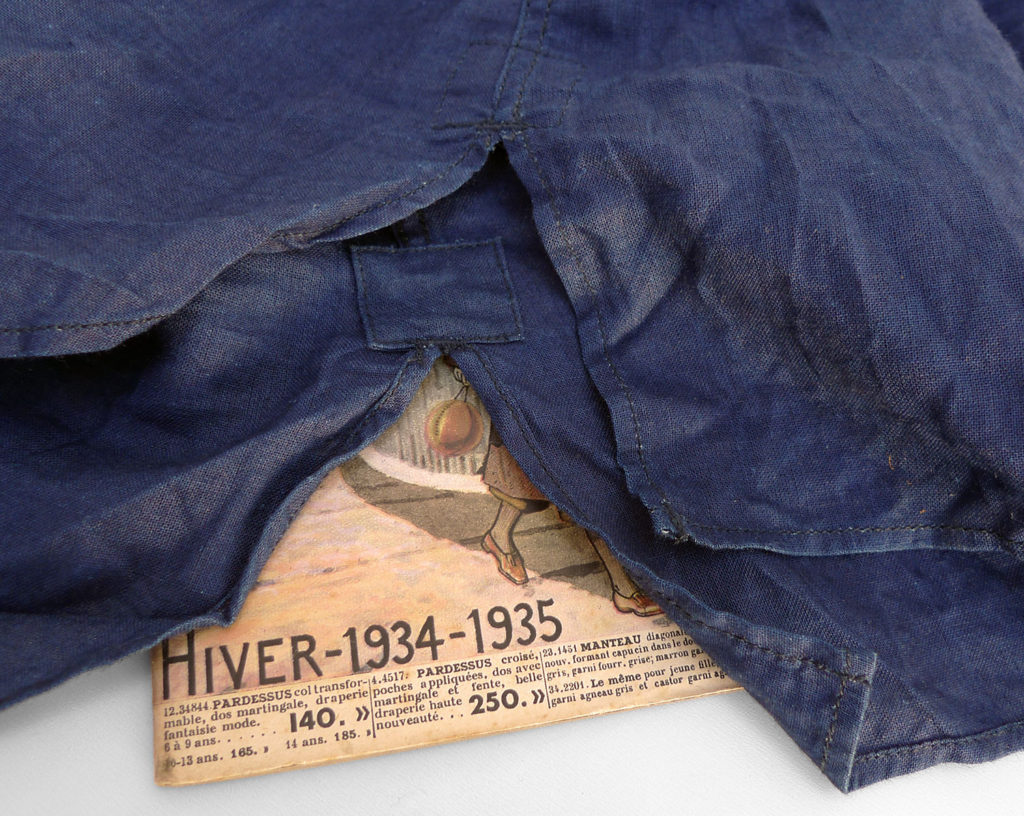
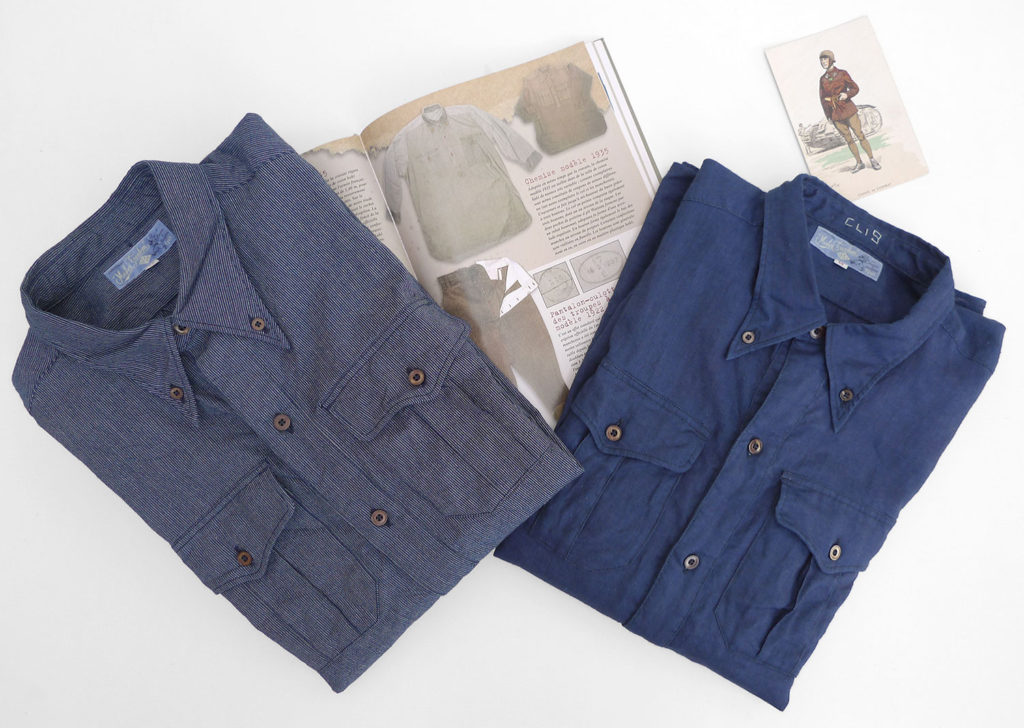 Mister Freedom® Liquette M35 (Book: Gazette Des Uniformes HS #21 “Les Equipages des Chars de Combat Français 1935/1940”) 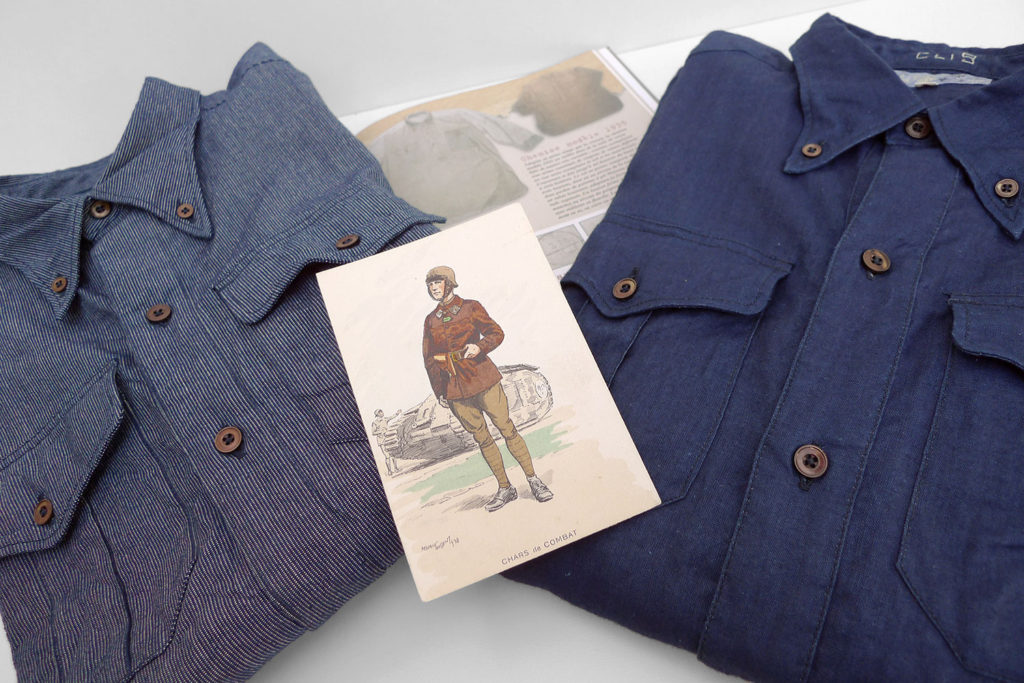
Mister Freedom® Liquette M35, Indigo Linen and Pin Stripe Ticking.
FW2019 mfsc “Pioupiou” Collection.
Made in Japan.
The Mister Freedom® x Sugar Cane Co Liquette M35 is the next installment of the mfsc “PIOUPIOU” collection, recently introduced with this post.
We are tapping into the Interwar period for this number, as the inspiration for our liquette (obsolete French colloquialism for men’s shirt) is the Chemise Modèle 1935, a pull-over shirt part of the French Army uniform, issued to soldiers during WW2. If our loose interpretation is not a straight-up replica, we still must give all tailoring credits to the anonymous designer commissioned by the Ministère de la Guerre at the time.
The specific collar pointy shape is known as “col Aiglon“, a design marking the beginnings of shirts showing under the tunic. The collar, designed to be complimented by a tie, is secured by three buttons, and features an attractive arcuate shape in the back. The pull-over pattern of the M35 has seen several modifications through the years, and if we opted-out of the epaulettes of the 1941 model, we incorporated the front expansion pleat of the 1940 model.
Those into nerding out on this stuff can refer to the excellent books released by Histoires & Collections, such as the out-of-print “1940 Le Soldat Français” by Olivier Bellec (2010).
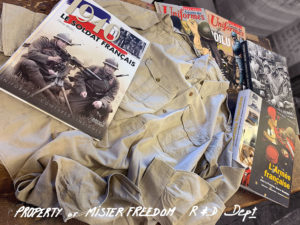
Our shirt features the two box-pleat flap front chest pockets of the original M35 military shirt, a pocket pattern known as “Pli Watteau” (Watteau fold), a contemporary reference to the back pleats of the Robe à la Française of the 18th Century, an extravagant fashion detail French painter Antoine Watteau often featured in his work.
The side gussets are the small patch style typical of French shirting of the period, and are featured both on the shirt tails and cuff slits. Front and rear tails are of contrasting shapes and length, and we left them a bit longer that contemporary un-tucked fashion dictates, as a period reference.
We opted for two fabric options for our 2019 version of the M35. The first is an old mfsc classic, an indigo stripe ticking previously featured on the Reno shirt of our Men of The Frontier days in 2012. Although stiff and crispy at first, this fabric ages beautifully and softens rapidly with wear. The original ticking we had milled at the time for our early western-wear shirt was actually duplicated from a vintage pair of WW1 French military private-purchase oddball jodhpurs from the MF® archives, still on display at the HQ, not too far from a genuine Pantalon Garance specimen.
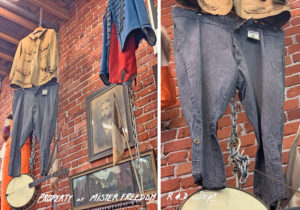
The second fabric option has absolutely no place in a Fall/Winter selection, but it was too beautiful to pass when it came up during fabric sourcing R&D. It is an indigo-dyed lightweight 100% linen plain weave shirting fabric with the attractive slub, crisp and drape typical of natural fiber linen. This gives the MF® M35 a very elegant touch, somewhat of an Italian fashion meets safari & military. This is an unintentional geographical reference as Il Duce was to bet on the wrong horse in WW2… As did Japan for that matter.
Note that this indigo linen textile is quite light sensitive so the indigo linen M35 should be stored away from the sunlight. With normal wear and regular home laundry cycles, both options will evolve into an interesting palette of blues.
The MF® Liquette M35 is designed in California by Mister Freedom® and manufactured in Japan by Sugar Cane Co.
SPECS:
PATTERN:
A pattern inspired by 1930’s French military uniform shirts.
FABRICS:
Two distinct options:
a) Indigo pin stripe ticking, 100% cotton, selvedge, 4.5 Oz, milled in Japan.
b) Indigo-dyed plain weave, 100% linen, lightweight with a slight sheer, milled in Japan.
DETAILS:
* Pull-over type, with front expansion pleat.
* Button-down pointy collar “Col Aiglon”, with rear arcuate shape.
* Two box pleat “Pli Watteau” chest pockets.
* Inside reinforcement patches for side gusset and cuff slit.
* Shirring on cuffs.
* Rounded front shirt tail and extended square back tail.
* Painted metal buttons.
* Original mfsc “Pioupiou” woven rayon label.
* Made in Japan.
SIZING/FIT:
Both fabric options of the MF® Liquette M35 come raw/un-rinsed.
We recommend the usual protocol before wearing:
* Cold soak for about 30-40mn, with occasional hand agitation.
* Spin dry and line dry.
* Wear briefly before fully-dry to set creases (does not apply to the indigo linen model), then hang until fully dry.
Both versions will fit approximately the same following the above procedure. Both indigo linen and indigo pin stripe ticking fabrics are so distinct in texture, weight and drape that they will feel completely different, but technically fit the same.
I am usually a Medium (15½) in mfsc shirting, and I opted for a comfortable Medium in both fabric options. The fit picture features a Medium M35 in both fabrics after one cold soak/line dry, and a bit more shrinkage and fabric torque/puckering is to be expected down the line.
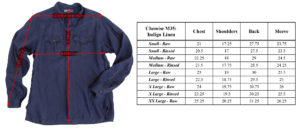 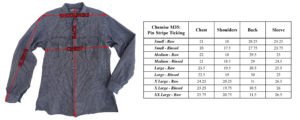
CARE:
Launder when needed.
a) Indigo pin stripe ticking model: Treat as a denim shirt. We recommend turning indigo blue/denim garments inside out to avoid marbling during laundering. Machine wash, cold water, gentle cycle, eco-friendly mild detergent and line dry.
b) Indigo linen model: Treat as a delicate fancy shirt. Un-button collar before laundering. Hand wash or machine wash on gentle cycle, cold water, minimum eco-friendly mild detergent and line dry.
Attractive patina will potentially develop according to activities and frequency of wear.
Please note that indigo might cause color transfer, and potentially “bleed” on light-colored garments, furniture, and skin.
The indigo dye of the linen M35 model is particularly light-sensitive and the shirt should be stored away from sunlight.
Available RAW/unwashed.
SIZES:
14½ (Small)
15½ (Medium)
16½ (Large)
17½ (X-Large)
18½ (XX-Large)
Available from our Los Angeles brick & mortar HQ, from www.misterfreedom.com, and fine retailers around the World.
Email sales@misterfreedom.com or call 323-653-2014 with any questions unanswered above.
Thank you for your support,
Christophe Loiron
Mister Freedom®
©2019
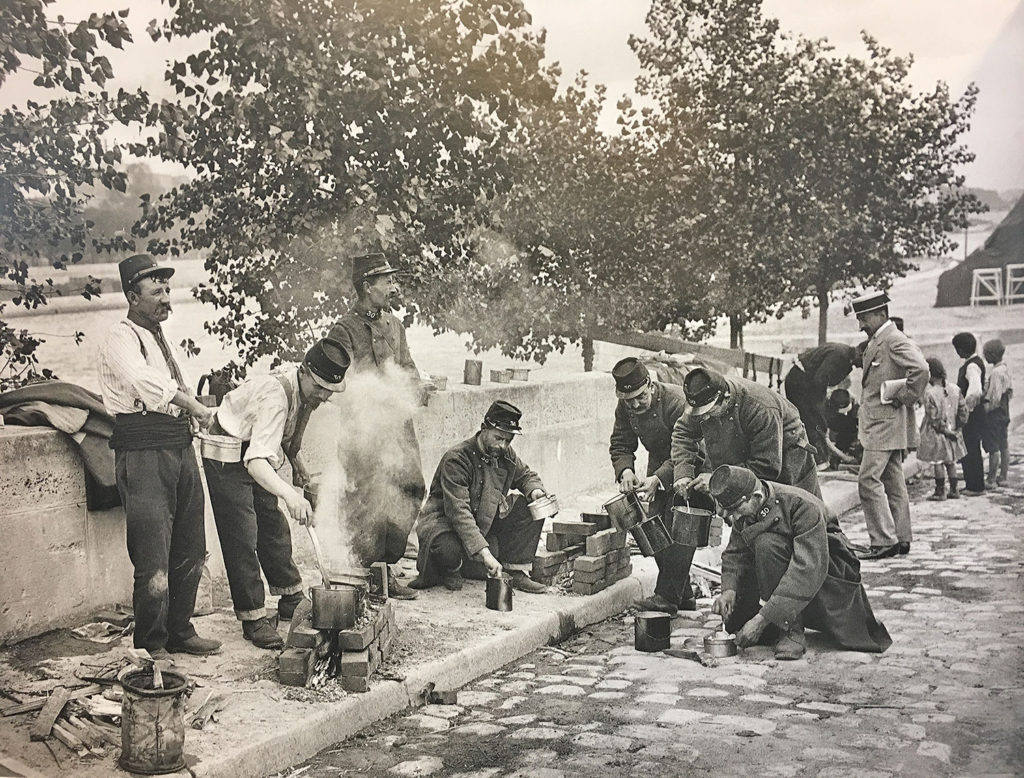 Á la soupe! (1914)
Photo by Jacques Moreau from the book “1914-1918 Nous étions des hommes” Courtesy Edition de la Martinière ©2004 Mister Freedom® FW2019 mfsc Pantalon “Le VAILLANT”: Indigo-dyed Linen-Cotton model.
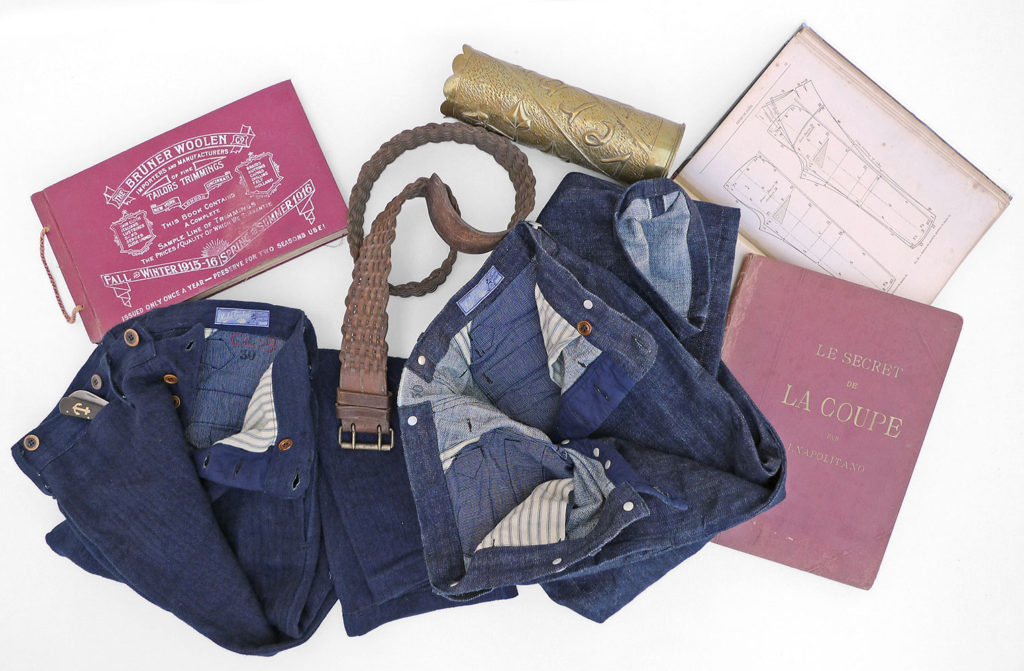

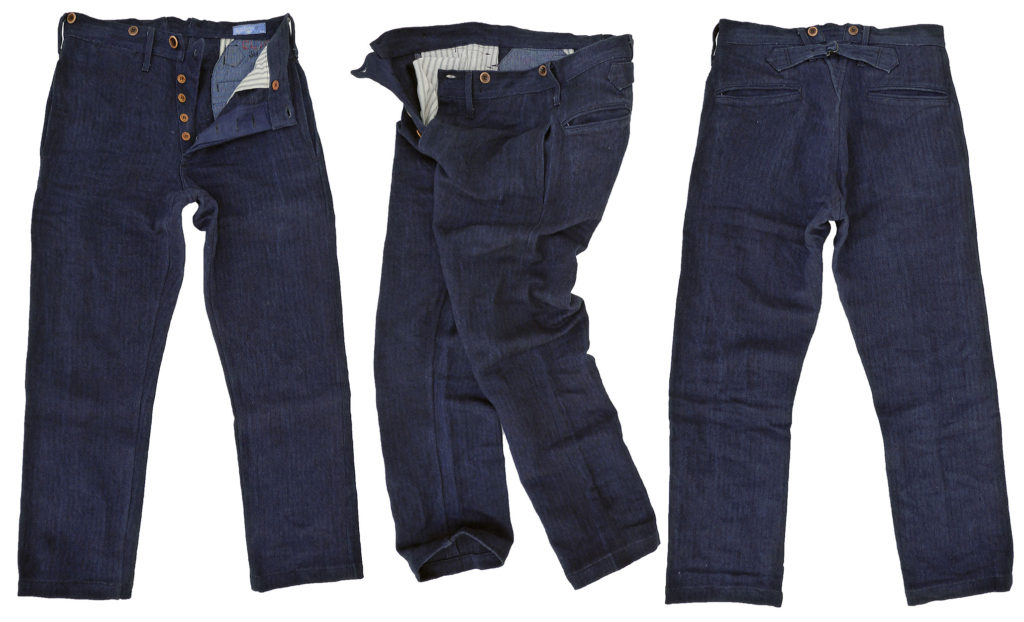 
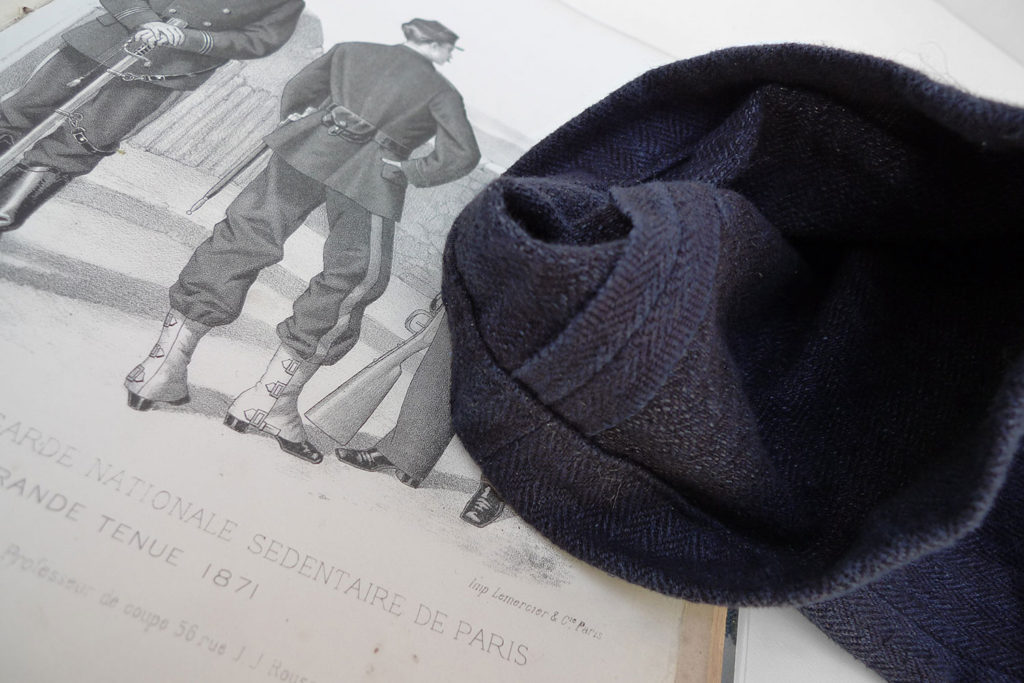
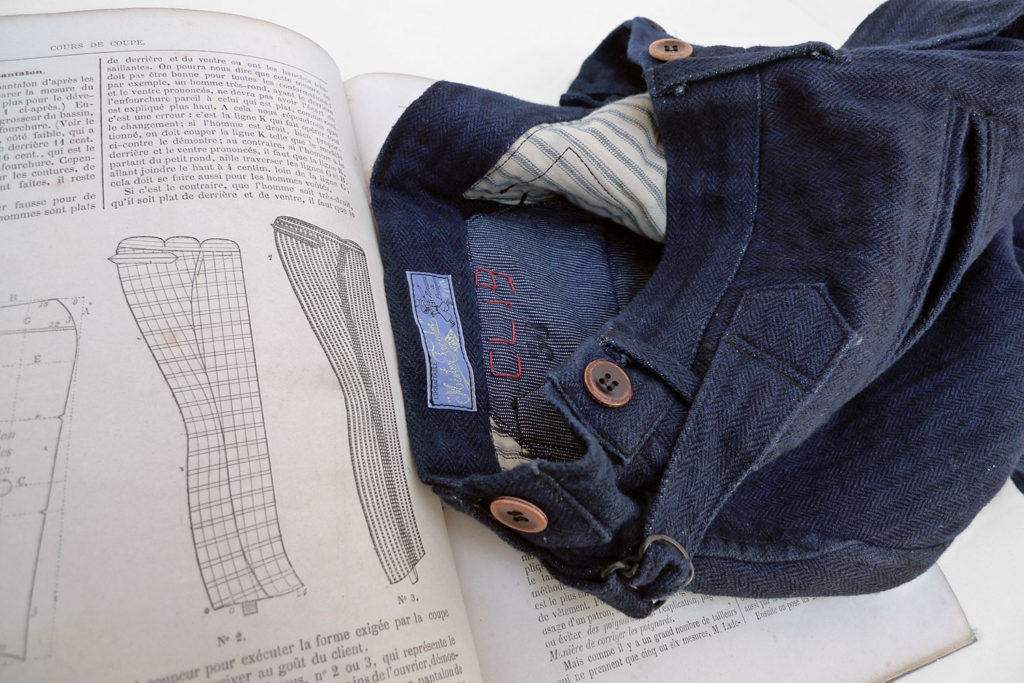
 Pantalon “Le Vaillant” (2019) and worn “Le Valseur” (2017), cut from the same indigo-dyed HBT Linen/Cotton.
-
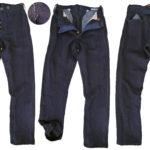
-
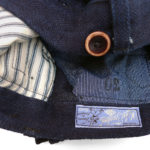
-
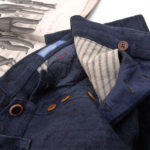
-
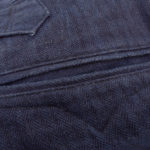
-
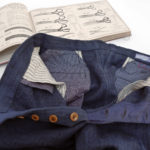
-
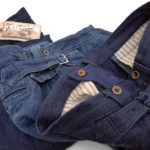
-
“Le Vaillant” (2019) and worn “Le Valseur” (2017), cut from the same indigo-dyed HBT Linen/Cotton.
Mister Freedom® FW2019 mfsc Pantalon “Le VAILLANT”: SC401 “Hawaii” selvedge denim model.
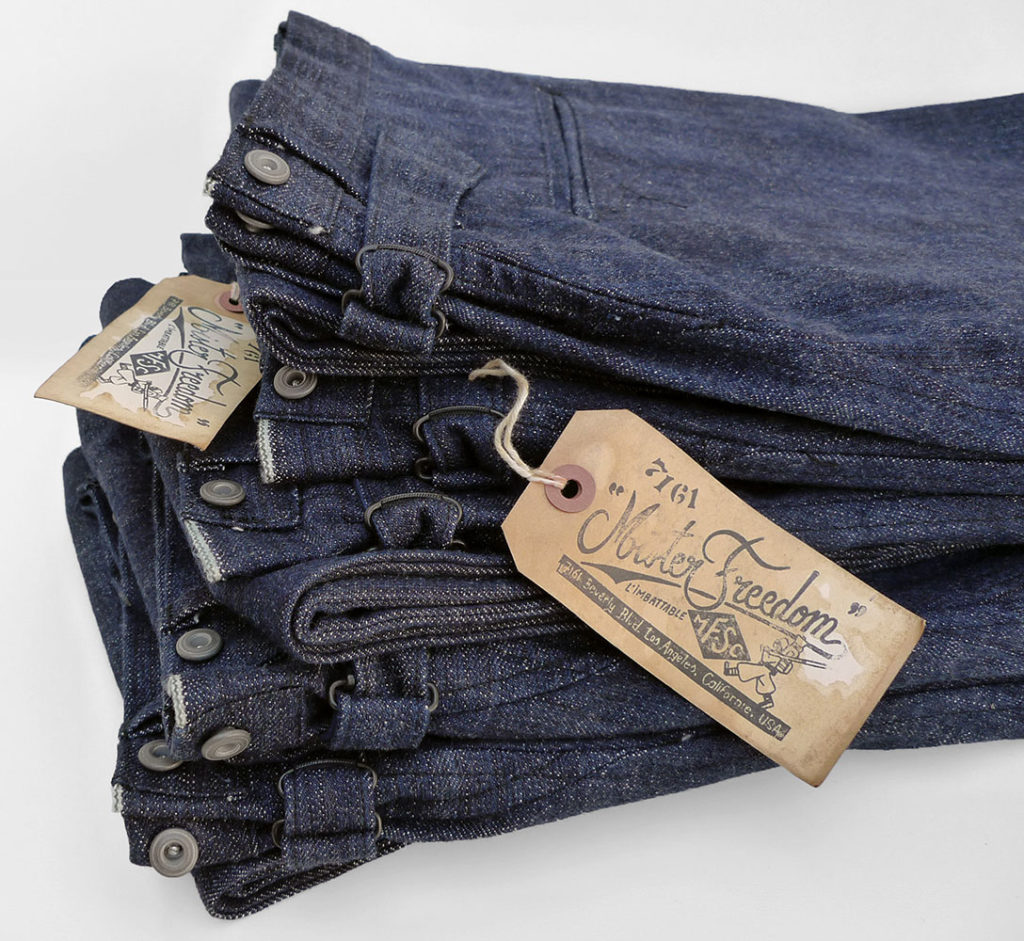
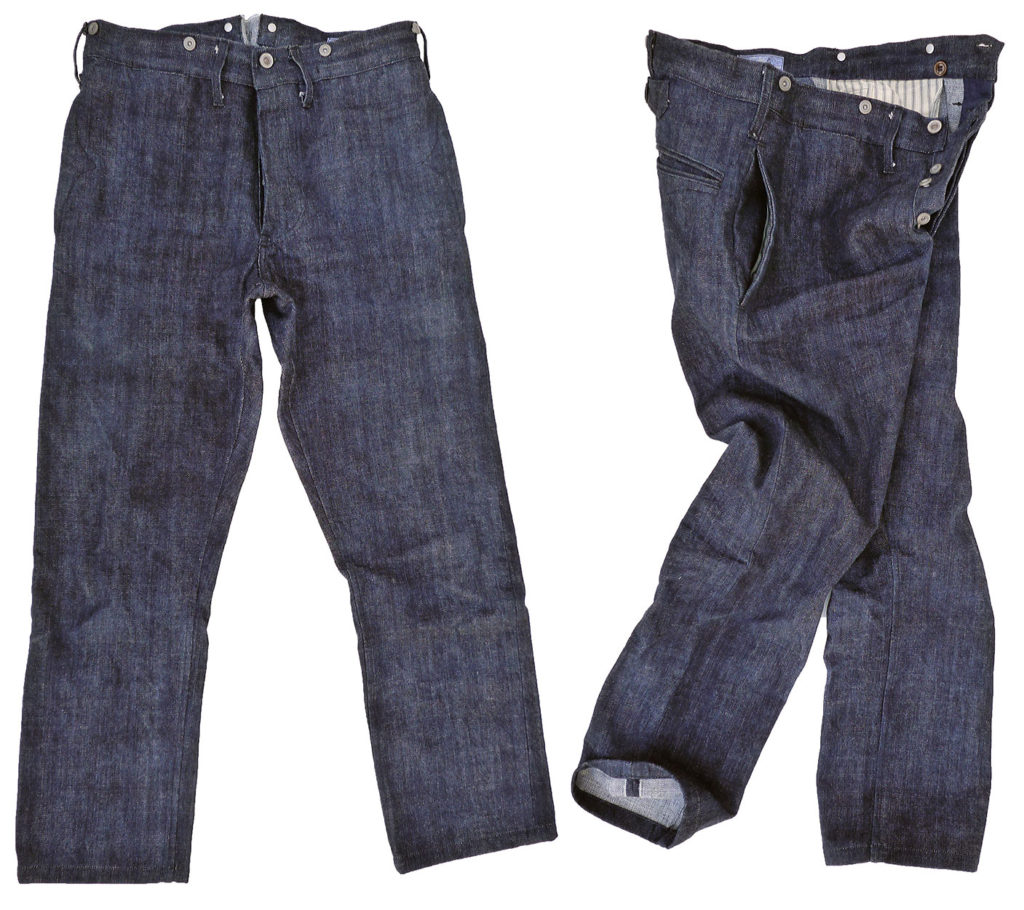
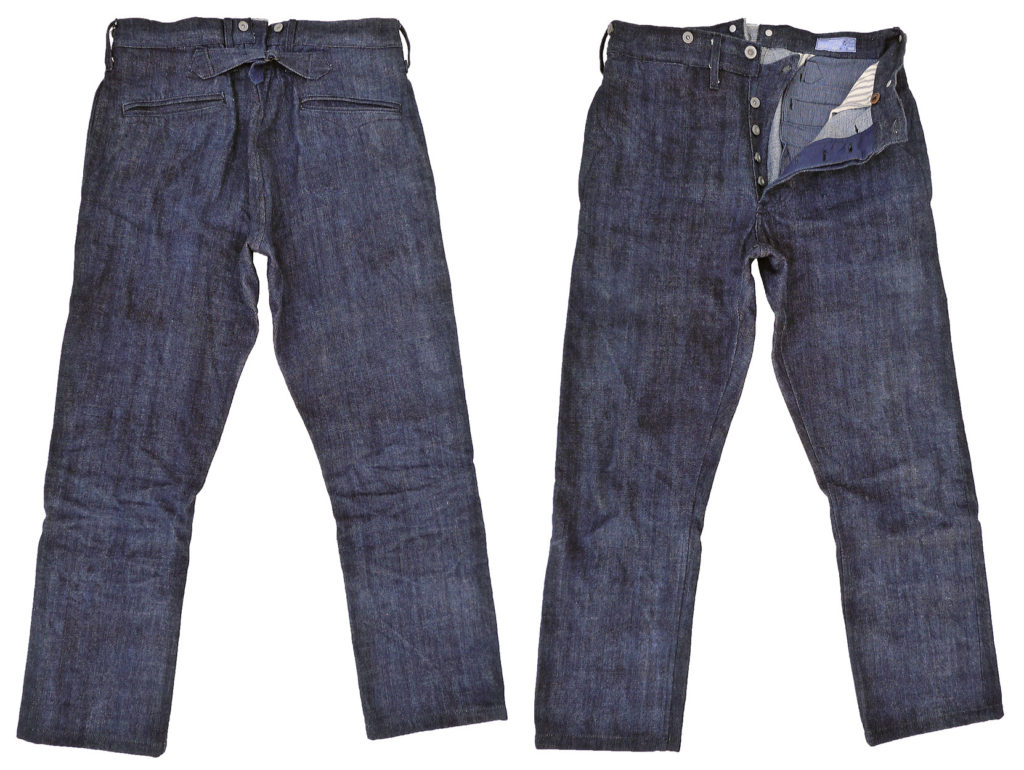
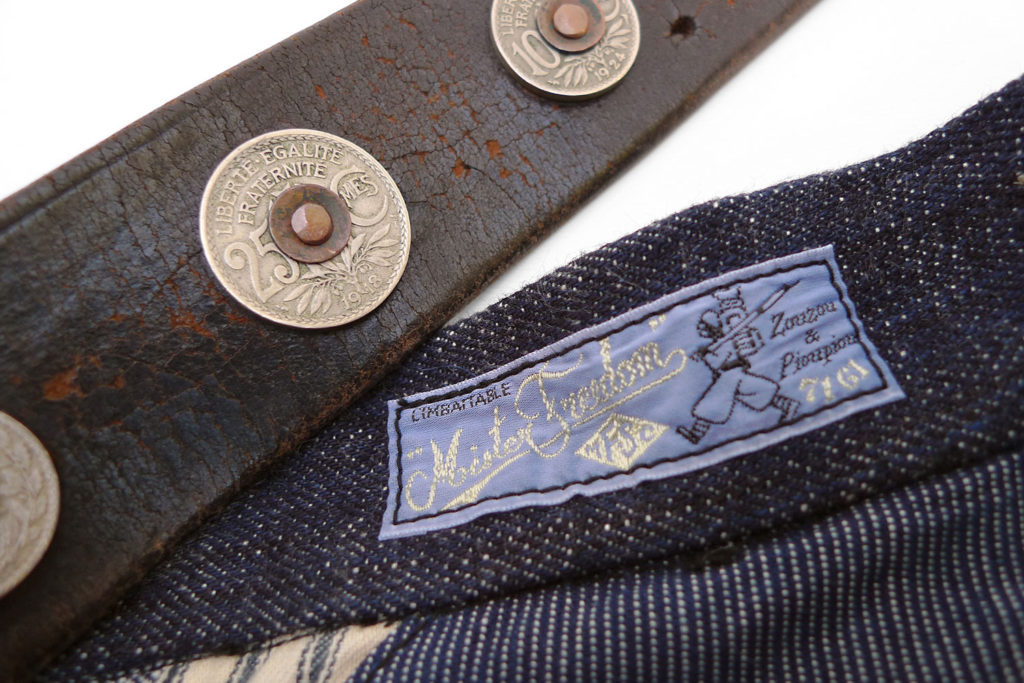
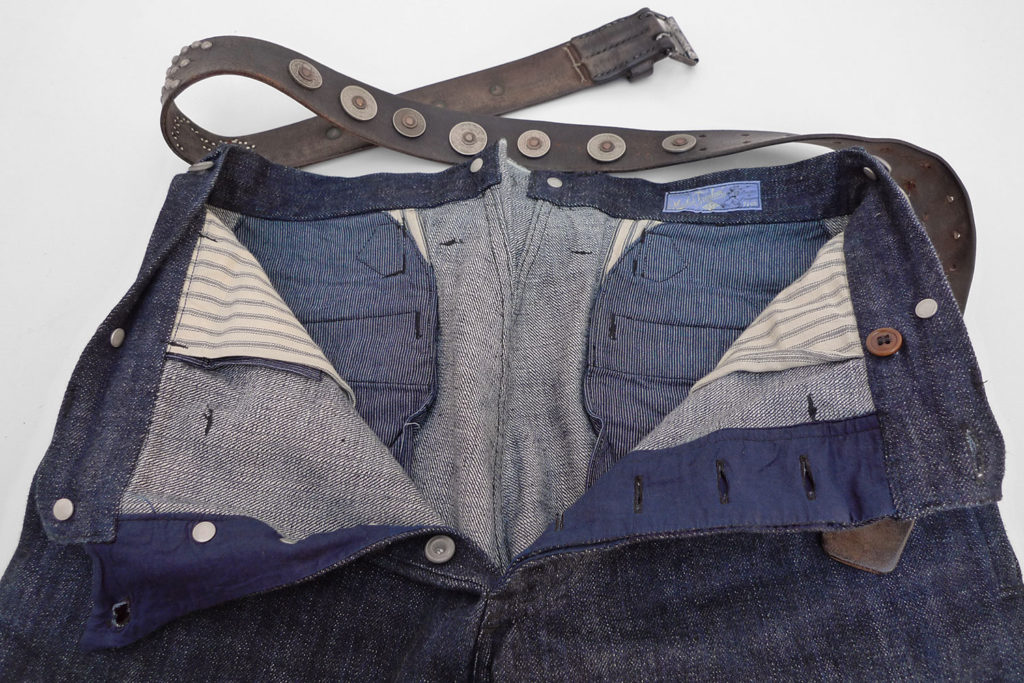
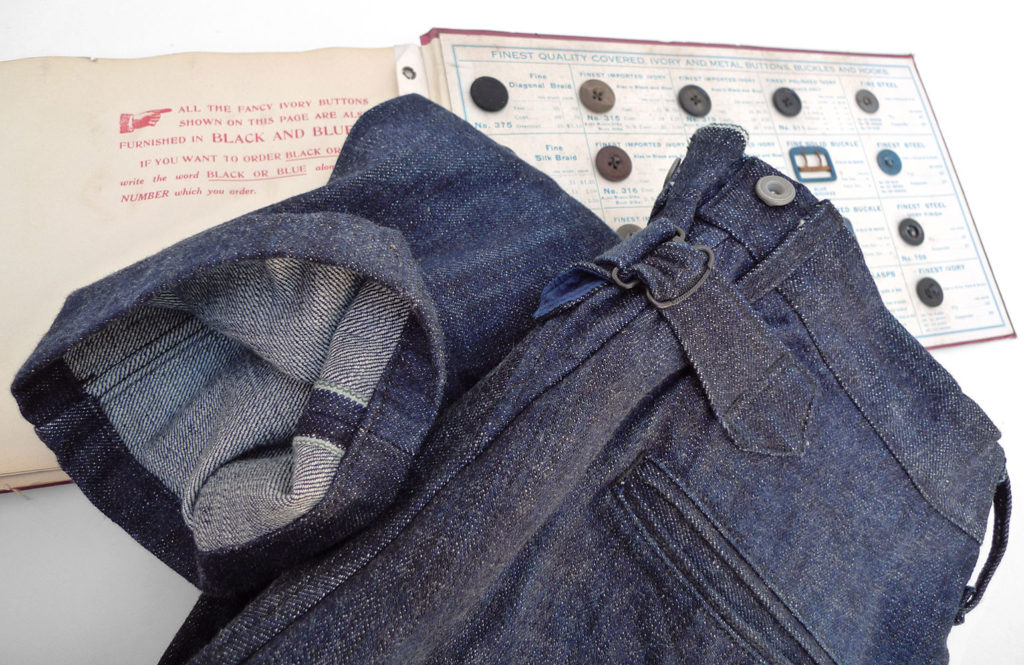

Mister Freedom® x Sugar Cane Co Pantalon “Le VAILLANT”.
FW2019 mfsc “PIOUPIOU” Collection.
Made in Japan.
We introduced the historical background of our FW2019 mfsc “PIOUPIOU” collection with the recent release of the Mécano Jacket. The “VAILLANT” is the matching bottom that completes this jacket/trousers ‘fictitious’ set.
As mentioned in that intro, the flamboyant red trousers (the infamous Modèle 1867 Pantalon Garance) flashed by the pioupious at the onset of WW1 proved fateful for many. Well-adapted for gun smoke-filled battlefield of the 1830’s (the trousers original design dated back to 1829), when the vibrant red color helped French soldiers spot comrades amidst thick black gunpowder clouds, these fancy trousers proved totally unsuitable for the modern international warfare of 1914.
As soon as October 1914, the French Minister of the Armies ordered thousands of indigo-blue light-weight canvas work trousers (of civilian origin and designs, as worn by mechanics and blue-collar workers) to be requisitioned, dispatched to soldiers, and urgently worn over the Pantalon Garance. This triggered last minute production of tens of thousands of indigo blue overalls…
As an anecdote, I remember scoring a very large amount of similar work trousers in a Paris flea market (Puces de Montreuil), sometime in the early 2000’s, when the Parisian Puces promised more than Bob Marley T-shirts and used fast fashion junk. It must have been around 06:00AM when I spotted a dealer unloading bundles after bundles of blue pants from his truck… Surviving the initial heart attack, I suggested he’d leave them inside, and painstakingly cut a deal. And hour later, I was loading my rental car with about 150 pairs of NOS 1920’s-40’s indigo buckle-back vintage work pants! Some specimen from that lucky haul have survived after all those years, and are now part of the Mister Freedom® HQ archives. These are completely generic and very similar to the hastily-produced indigo overalls issued to French Poilus in 1915, and probably share the same manufacturing factories.
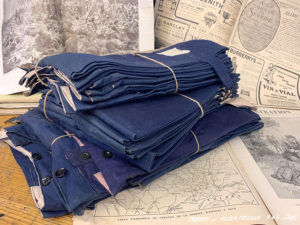 NOS 1920’s-40’s French utility pants loot, surviving specimen of a Parisian flea market lucky find in the early 2000s. Before fashion designer Paul Poiret got commissioned to draft new outfits for French infantry troops (source here), leading to the familiar Bleu Horizon woolen uniforms issued at the end of 1915, civilian garments were often adopted by weary Poilus, as seen on period documents. Indigo blue mechanic overalls, drab corduroy (Velour d’Amiens) or coutil hunting jodhpurs, civvy leather brodequins, non-regulation stripe flannel shirts and jury-rigged sheepskin ponchos, hand-knit wool scarves sent to the front by anguished mothers and wives… All this, added to raw material restrictions and to the chaos of war, definitely made for an eclectically-clad bunch on the battlefields.
Check out the photographic works of Jacques Moreau in the book “1914-1918 Nous Étions Des Hommes” for vivid, rarely-seen hi-res visuals of Poilus in the field and in their daily life, chronologically documented. Fascinating.
Design-wise, the pattern of our Pantalon “Le VAILLANT” (French spelling for the word valiant) is inspired by late 1800’s utility and uniform trousers, the afore mentioned M1867 Pantalon Garance, and the classic white HBT linen M1882 bourgeron chore fatigues. Again, our rendition is a wearable hybrid and not a replica.
If we kept the traditional expansion gusset/cinch strap, we added two rear welt pockets, as pants without rear pockets are a bit hard to pull-off in 2019. Then came the pocketing/lining challenge… a tailoring puzzle skillfully solved by Mr. Fukutomi, Toyo Enterprise’s talented pattern-maker! We are partial to no open seams/no overlock in general, so the inside of our garments often become an elaborate textile origami of folded fabrics and seams.
We played with fabrics and pocketing patterns to let both indigo and white stripe tickings compliment each others, a concealed visual treat for the vintage clothing aficionado and tailoring connoisseur. The MF® Advertising Dept suggested “With the Pantalon Le VAILLANT, impress with what’s inside the trousers!“, but it probably won’t fly.
Anyways, the pocket openings are decorated with arcuate stitching, typical of turn-of-the-Century Old World tailoring. We also added thin belt loops for practicality, since suspenders are not everyone’s cup of tea. The extended button waist tab is a period detail. The button fly facing is cut from indigo-dyed poplin, for another serving of visual stimulation and a guarantee of interesting patina down the line.
Just as its Mécano amigo, our “Le VAILLANT” comes in two distinct fabric options. The first is a deep indigo-dyed linen/cotton herringbone twill (HBT), an old mfsc favorite with very rewarding patina potential. This linen-cotton blend fabric we developed a few years ago was inspired by late 1880’s French Firemen uniforms. It has been previously featured on the Valseur, Veste Belleville and Gilet Gadjo of the 2017 mfsc Gypsy Blues collection.
We also thought an “Americanized” version would be an interesting hybrid, so we are offering the “Le VAILLANT” in a sturdy 14 Oz. “401 Hawaii” selvedge dark indigo-dyed denim twill. This blend of 50% cotton and 50% recycled sugarcane fibers is milled in Japan exclusively for Sugar Cane Co. The “401” will be familiar to MF® OGs, as it was featured on the right leg of the original mfsc UFO, aka “7161” Utility Trousers released in 2006. This is the first time in 13 years that we are using this beautiful fabric again, with its characteristic subtle indigo shade variations in the yarns, its interesting denim nep, and attractive slub.
The 401 denim “Le VAILLANT” option is complimented by early workwear-style metal tack buttons with dull aluminum finish, while the HBT model features genuine bone suspender buttons.
Finally, our original FW2019 “Pioupiou” woven label design features a hardy and mighty Zouave (zouzou in military jargon of the period), and is a reference to La Coloniale and its often eluded 590,000 man-strong participation in the Allied victory of WW1. The specific grayish blue color of the label is a reference to the classic 1915 “Bleu Horizon” afore mentioned.
The MF® Pantalon “Le VAILLANT” is designed in California by Mister Freedom® and manufactured in Japan by Sugar Cane Co.
SPECS:
PATTERN:
An original mfsc pattern inspired by vintage French military late 1800’s utility and uniform trousers, such as the Modèle 1867 Pantalon Garance, and the classic natural HBT linen M1882 bourgeron.
FABRICS:
Two distinct options:
a) Dark indigo-dyed 15 Oz. blend of 80% linen and 20% cotton herringbone twill (HBT), selvedge, milled in Japan.
b) Sturdy 14 Oz. “401 Hawaii” dark indigo-dyed denim twill, a blend of 50% cotton and 50% recycled sugarcane fibers. White w/ green line selvedge ID. Milled in Japan exclusively for Sugar Cane Co.
DETAILS:
- Vintage-inspired silhouette with slightly tapered leg and medium-high rise.
- Traditional rear cinch strap and selvedge expansion gusset with split waist band.
- Two rear welt pockets, coin pocket and slash side pockets.
- Decorative arcuate stitch on pocket openings.
- Spilt outseams displaying fabric selvedge.
- Thin trousers-style belt loops for wider belts.
- Suspender buttons:
a) Genuine bone with attractive finish for the indigo HBT Le VAILLANT.
b) 1930’s style metal tack buttons with dull aluminum finish for the denim Le VAILLANT.
- Fly buttons:
a) Amber brown corrozo for the indigo HBT Le VAILLANT.
b) Utilitarian donut type with dull aluminum finish for the denim Le VAILLANT.
- Pocketing: attractive combination of cotton indigo stripe ticking, white stripe ticking and indigo-dyed cotton poplin.
- Original mfsc “Pioupiou” woven rayon label.
- Made in Japan.
SIZING/FIT:
Both versions of the “Le VAILLANT” come raw/un-rinsed. We recommend the usual protocol before wearing:
- Cold soak for about 30-40mn, with occasional hand agitation.
- Spin dry and line dry.
- Wear briefly before fully-dry to set creases, then hang until fully dry.
Both versions will fit approximately the same following the above procedure, although the denim “Le VAILLANT” feels roomier because our mfsc shrink tests are done with heat-dried garments. There is therefore more shrinkage to be expected for the denim version with subsequent washing, or if a heat dryer is used.
We don’t recommend heat drying as this tends to soften garments, ‘break’ the fabric starch, and result in unsightly fold creases or marbling marks. Garment stiffness after a soak/line dry will subside rapidly with normal wear.
Fit: Due to the split waistband/rear expansion gusset pattern, the “Le VAILLANT” have a generous waist. Fully cinching the back strap will take in the waist by about 1 ½ inch. If your waist measures an actual 32 inches, the “Le VAILLANT” W32 will have a generous seat leg and a very comfortable fit. For a slimmer silhouette, if your waistline allows it, sizing down is an option. I usual wear W32 in mfsc trousers, but opted to size-down to a W30 for these, for a tighter seat and tapered leg silhouette.
Hemming: The bottom hem on both models is done using a single needle machine, no special chainstitch machine required. Not a fan of contemporary stacking, I opted to crop “Le VAILLLANT” quite high, above the traditional trousers’ break.
Regardless of the length of your liking, these trousers might look better traditionally hemmed than with Wild Ones denim rolls, unless you go with the full leg silhouette.
Please refer to sizing chart for measurements, reflecting a 30-40mn cold soak/spin dry/line dry process, resulting in minimal shrinkage. The raw measurements are given for reference only, as the numbers that actually matter are post soak. We do believe that, according to frequency of use, washable garments should be laundered when needed, and not kept ‘raw’.
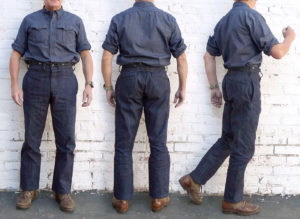
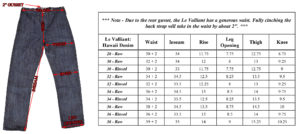 “Le Vaillant” 401 Denim
CARE:
Launder when needed.
We recommend turning indigo blue/denim garments inside out to avoid marbling during laundering. Machine wash, cold water, gentle cycle, eco-friendly mild detergent and line dry.
Potential attractive patina will develop according to activities and frequency of wear.
Please note that dark indigo might cause color transfer, and potentially “bleed” on light-colored garments, furniture, and skin.
Available raw/unwashed.
Sizes
W28
W30
W32
W34
W36
W38
Available from www.misterfreedom.com, our Los Angeles brick & mortar store, and fine retailers around the World.
Email sales@misterfreedom.com or call 323-653-2014 with any questions unanswered above.
Thank you for your support,
Christophe Loiron
Mister Freedom® 2019
Mister Freedom® mfsc FW2019 “Mécano” Jacket, indigo-dyed HBT model.
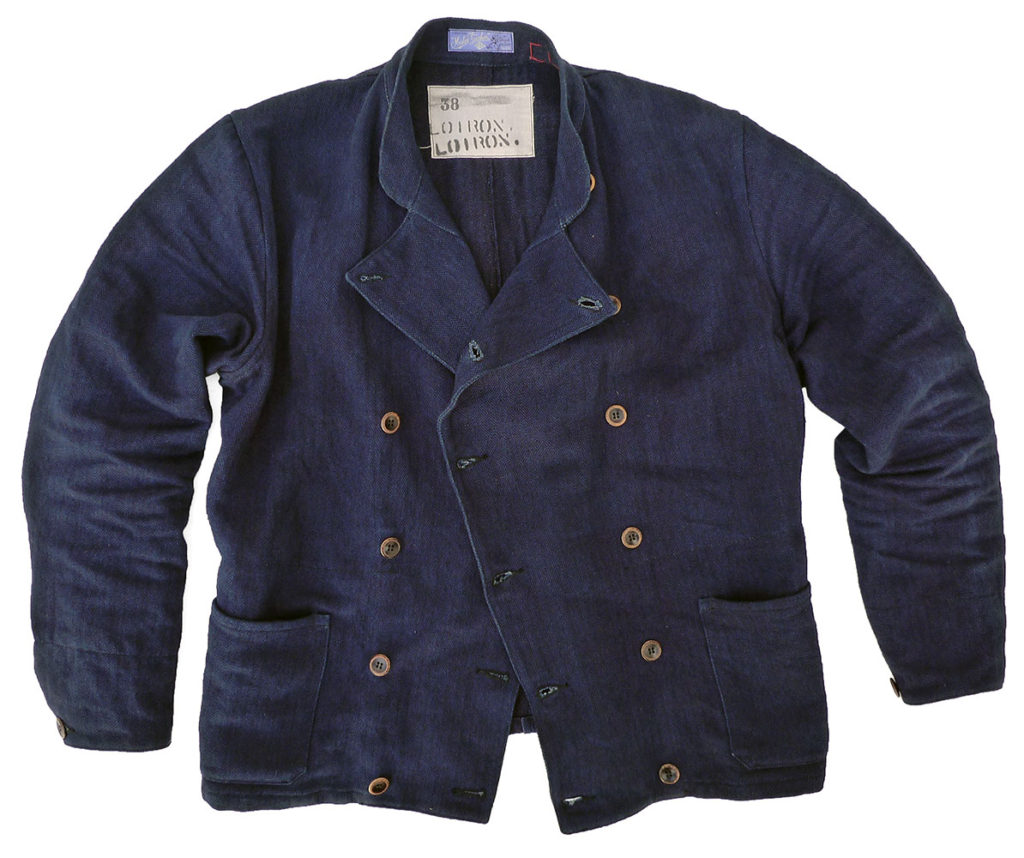


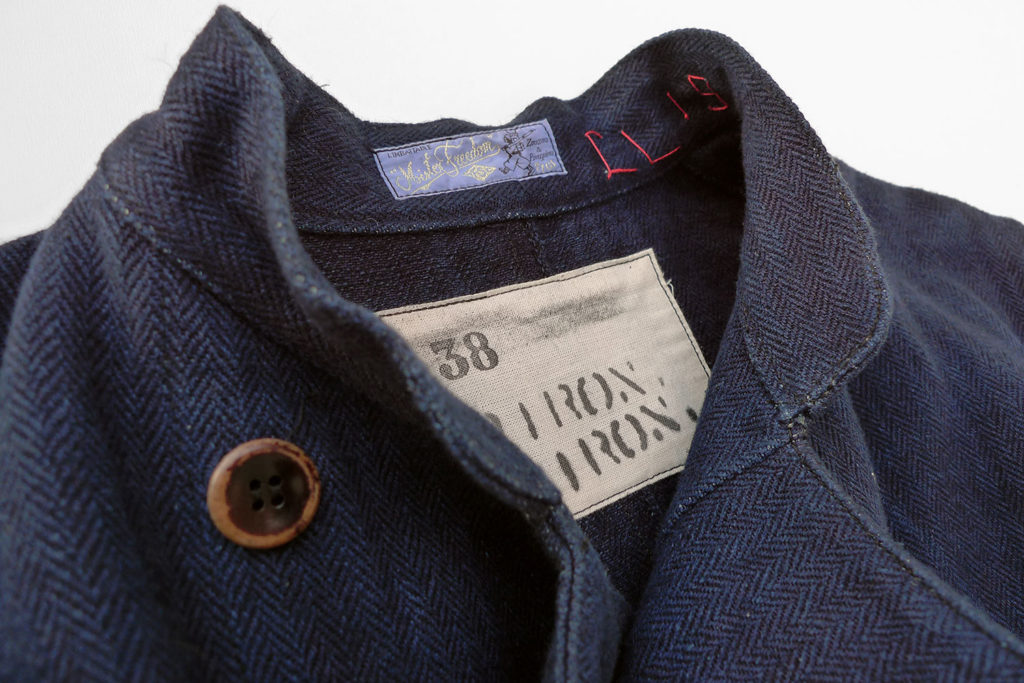
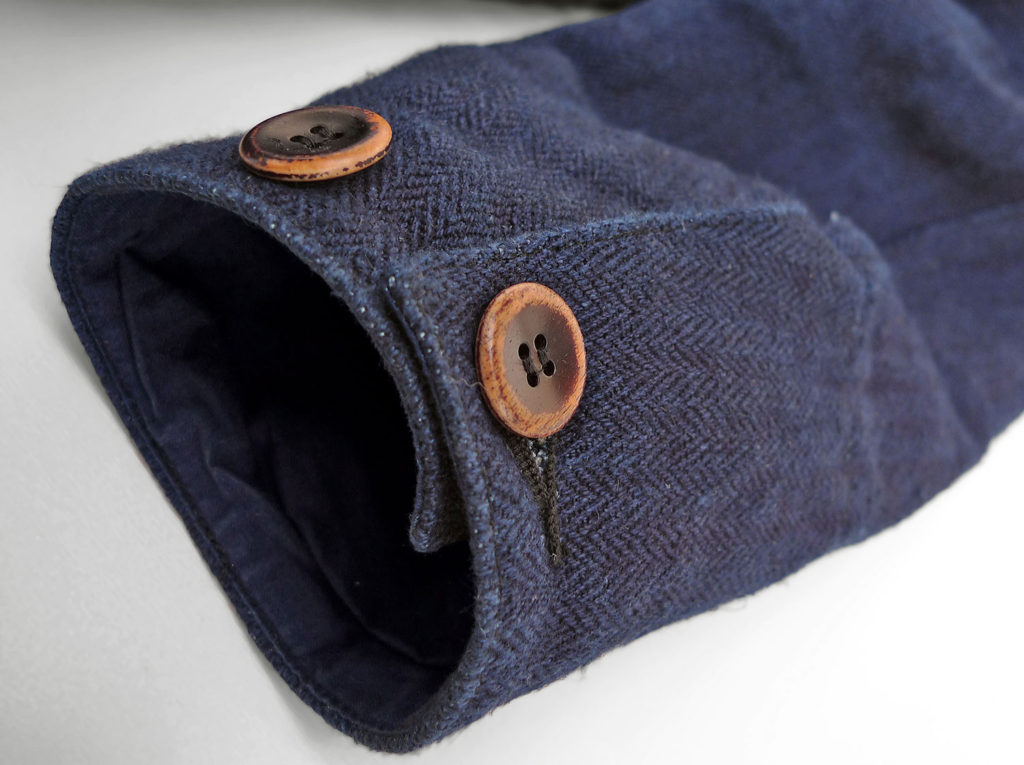
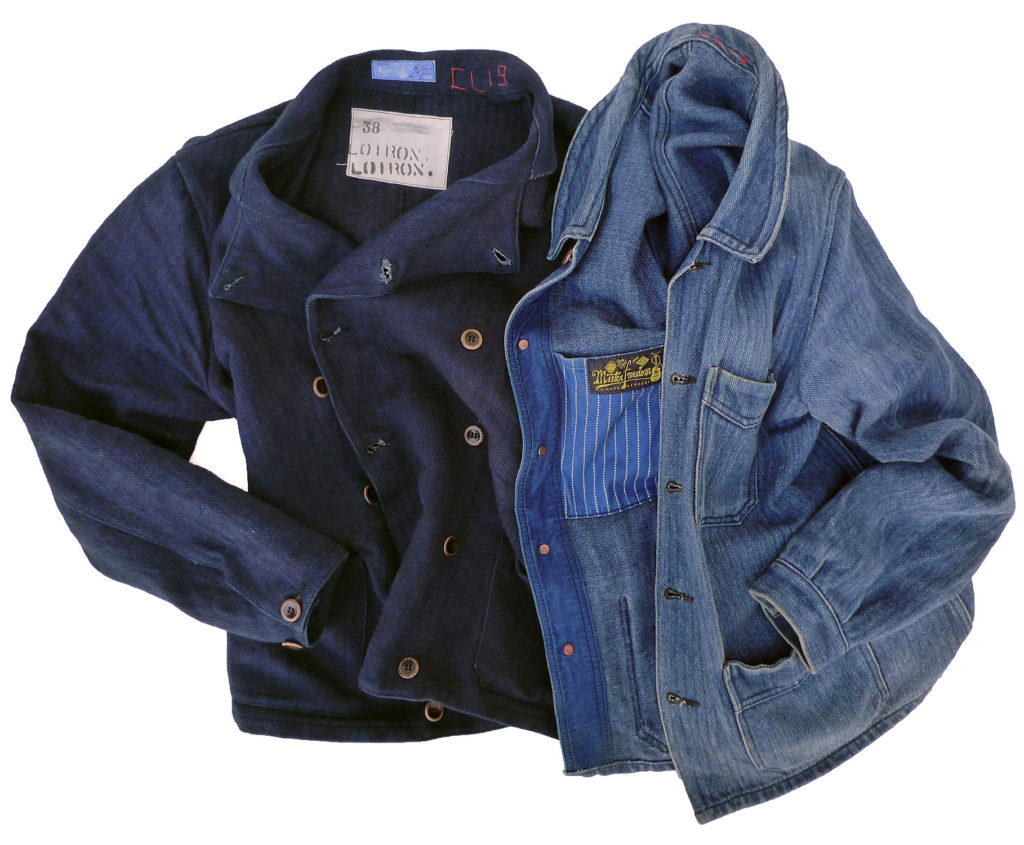 MF® 2019 “Mecano” and well-worn 2017 “Belleville“, featuring the same indigo-dyed HBT linen-cotton fabric. 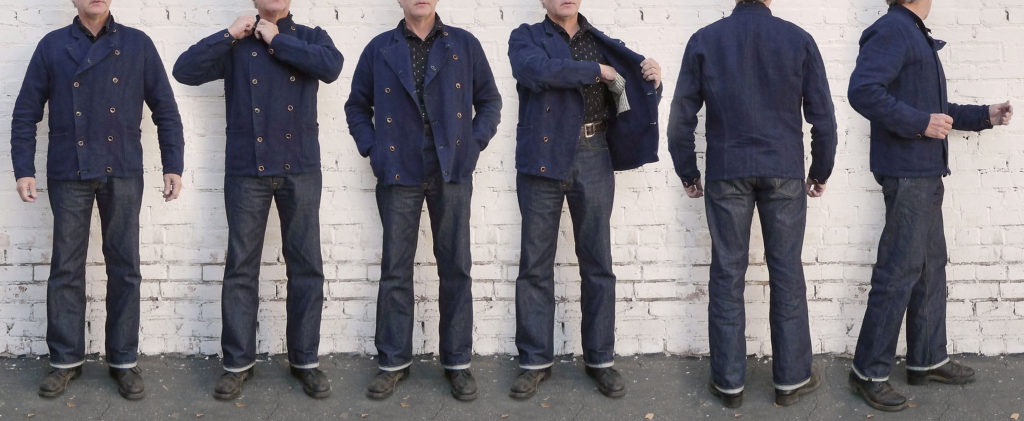 MF® 2019 “Mecano” size 38, indigo-dyed HBT model. Mister Freedom® mfsc FW2019 “Mécano” Jacket, 14 Oz. SC401 ‘Hawaii’ denim model.
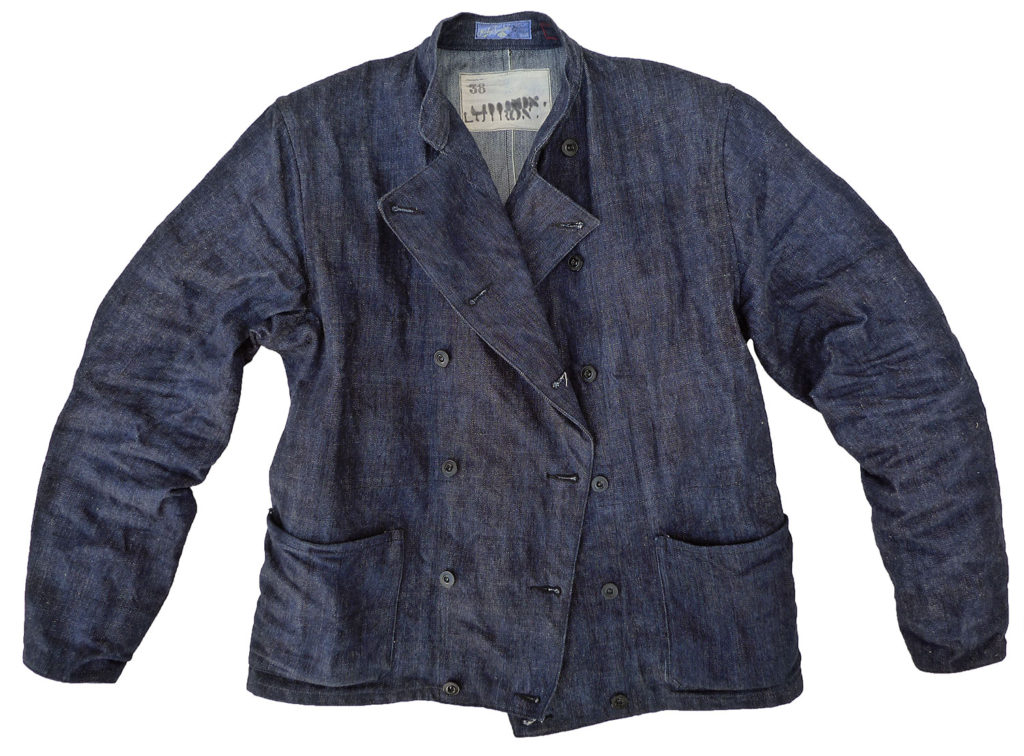


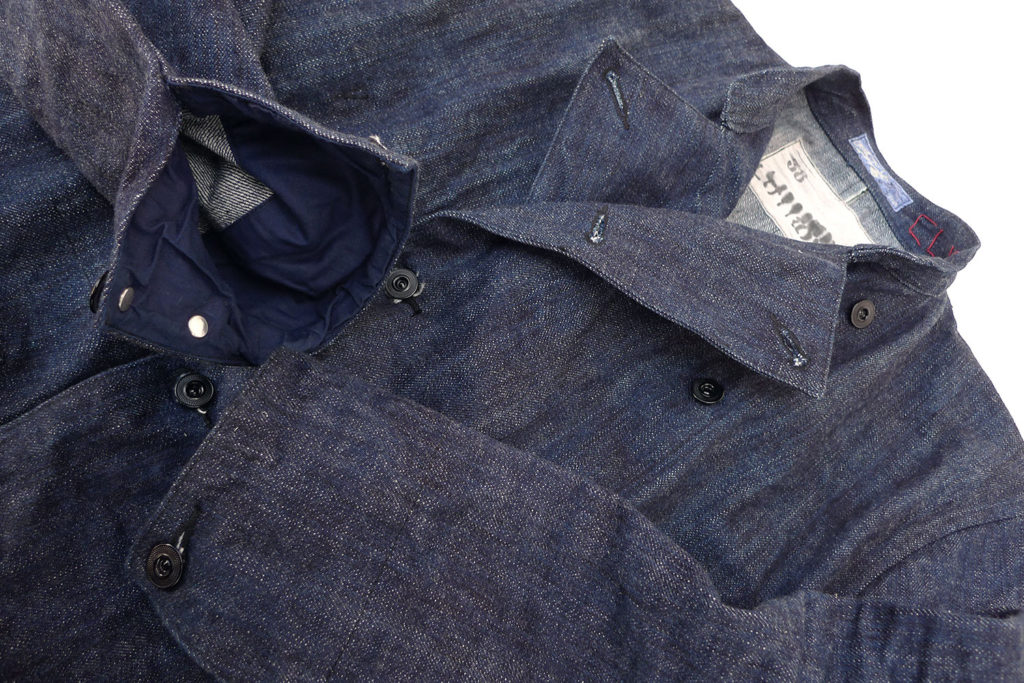
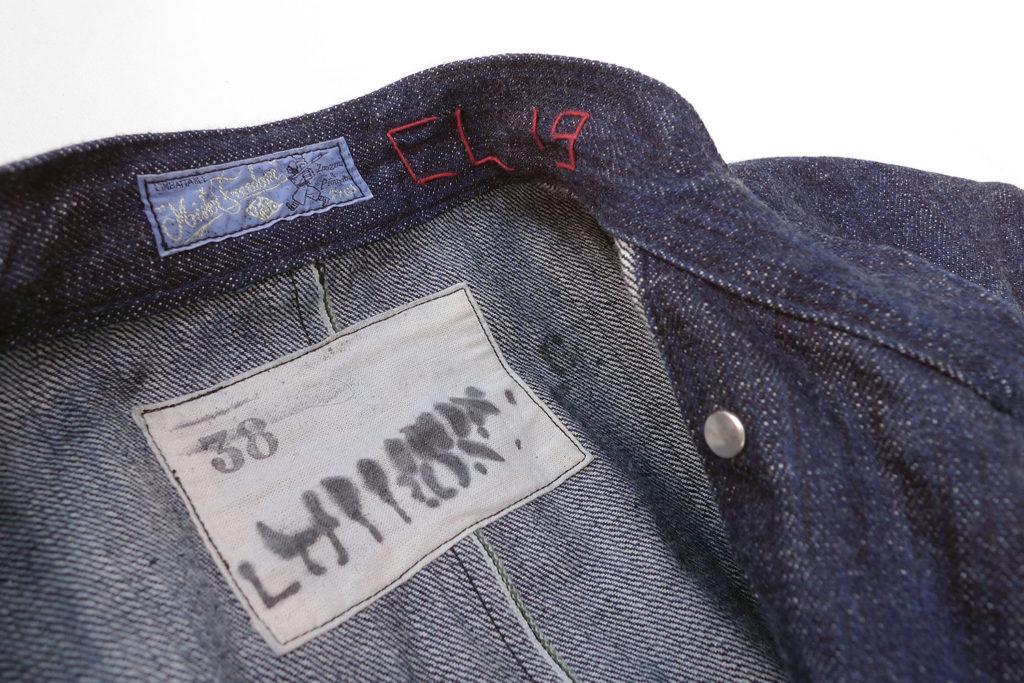
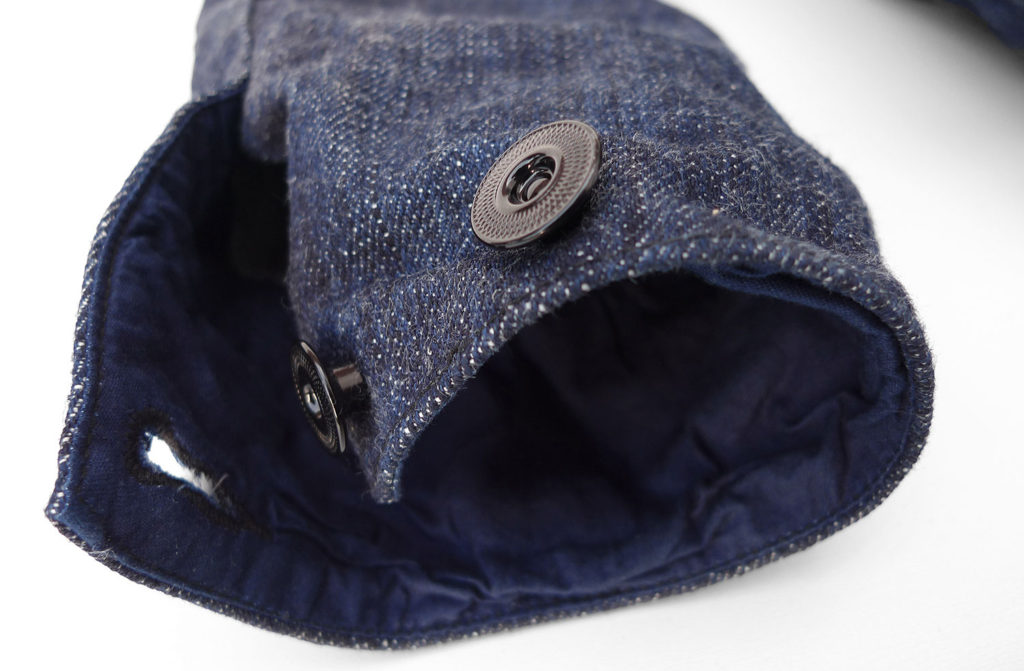
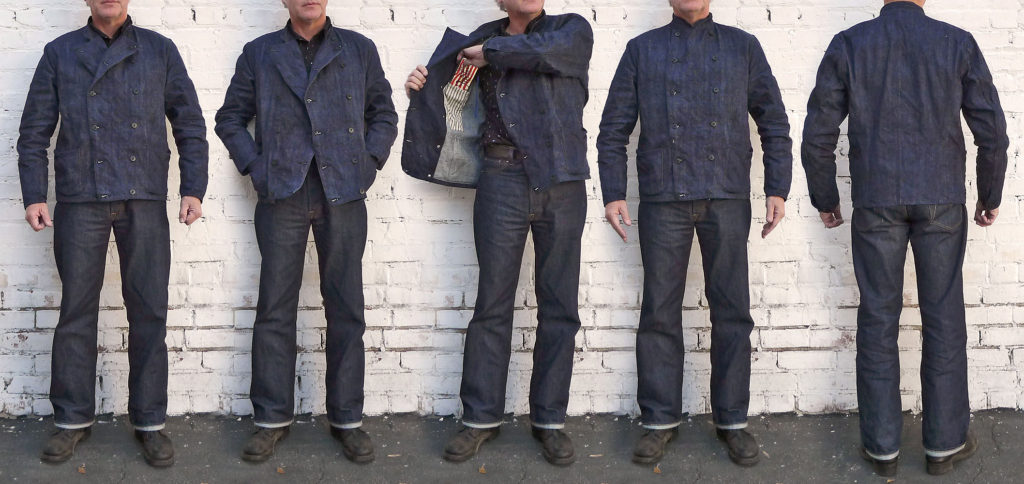 MF® 2019 “Mecano” size 38, SC401 ‘Hawaii’ denim model. Mister Freedom® x Sugar Cane Co “MÉCANO” Jacket.
FW2019 mfsc “PIOUPIOU” Collection.
Made in Japan.
This Mécano Jacket release officially launches our FW2019 mfsc “PIOUPIOU” capsule collection.
Etymologically, the word pioupiou – as a reference to a young conscript – first appeared in “Le Pioupiou ou la gloire et l’amour”, a 1838 play by vaudevillian Antoine-Francois Varner.
What’s a pioupiou? The obsolete term, pronounced pew-pew, was a happy-go-lucky nickname given to French soldiers heading out to the frontlines on the onset of WW1. The typical French grunt in 1914 was proudly sporting the flamboyant Model 1877 field uniform: Prussian blue wool capote (long coat), red kepi with matching flashy red trousers, the infamous pantalon garance. This stylish combo soon revealed to be quite ideal as enemy target practice in the field, and was soon replaced by the Bleu Horizon field uniform commonly associated with the French Army on the Western Front during the 1914-1918 conflict.
As that “Great War” dragged on, and trenches of the Western Front disclosed their terrifying reality via letters from the front (although censored), homecomings of Gueules Cassées, and Mort pour la France announcements, the cutesy pioupiou sobriquet quickly changed to “POILU” (literally ‘hairy’), ’tough guy’ or badass in period jargon… Despite the initial motivational efforts of the press, the concept of chair à canon soon started challenging the patriotic enthusiasm of the early days, and the ‘glamor’ of the War To End All Wars quickly faded.
By November 11, 1918 casualties in the French Army (impacting about 71% of those who fought in her ranks) reached 1.4M killed, and 4.2M wounded. Within the Allied Forces, France’s KIA numbers ranked second, topped by Russia’s 1.7M and followed by the British Empire’s, a bit shy of 1M. For reference, after joining the conflict in 1917, the loss of lives in the US Army would amount to about 116,000 by the end of 1918.
Last year, 2018, marked the centennial of WW1, with memorials and ceremonies abundantly relayed by the media. In 2013 had begun a collective effort encouraging French citizens to submit letters, photos, artifacts and original documents to be digitized and regrouped as public data. This Devoir de Mémoire (Obligation of Remembrance) made many a-French families dig-up personal archives. Some of the submitted WW1-related documents are regrouped here. Some stunning colorized photos can be found here.
The Mister Freedom® FW2019 mfsc “PIOUPIOU” collection is not an apology of war, nor an effort to romanticize it, but follows a belief in the importance of not forgetting our Past, in an attempt to stop repeating History and its inexorable “Only the dead have seen the end of war” lament ad vitam aeternam.
-

-
1888 pamphlet.
-

-
A “Joyeux” sporting the “pantalon garance”, circa 1914.
-
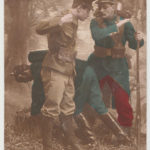
-
Tommy, Pioupiou, and Jerry, circa 1914.
-
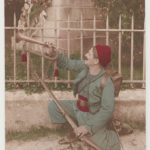
-
Zouzou.
-
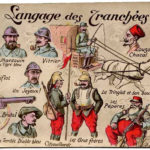
-
Language of the Trenches (1916)
-
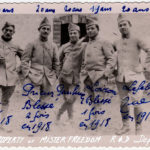
-
A 19yo Georges LOIRON (4th from left), 303e Regiment d’Infanterie, 23eCie, 1917. (Personal family archives ©2019)
-
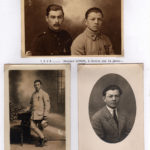
-
Georges LOIRON, with his head wound. (Personal family archives ©2019)
On a much lighter note, the FW2019 line-up we will gradually be releasing this season is loosely inspired by French military-issued garb of the 1910’s to the 1930’s. It blends period utility uniforms and revisited vintage civilian attire into contemporary wearables, following the usual MF® “might have been” design approach.
The MF® rag du jour is the Mécano Jacket.
If you are after one of the latest holy grail of vintage EU militaria, a Model 1923 double-breasted indigo bourgeron issued to French Army tankmen (tankists) in the interwar period, about as easy to find as a black cat in a coal mine, reach out to our friends and expert vintage hunters Jérome aka le Zouave, Damien from Le Magasin, Arnaud “French Cancan” Beauville, Tom Gruat, …
Not sure if replicas already exist of the M23 bourgeron, but the Mister Freedom® “Mécano” is our non-verbatim interpretation of this early French military chore jacket classic. We started our R&D journey with the pattern of a white cotton twill specimen dated 1916 from our archives (merci Damien.) If we kept the killer curvature of the front double-breasted panels, we tweaked the fit (sure needed it!), changed the cuff pattern and other details. After a dip in the mfsc secret sauce, our project had morphed into a cool wearable.
The Mécano comes in two distinct fabric options. The first is a deep indigo-dyed linen/cotton herringbone twill (HBT), an old mfsc favorite with very rewarding patina potential. This linen-cotton blend fabric we developed a few years ago was inspired by late 1880’s French Firemen uniforms. It has been previously featured on the Valseur, Veste Belleville and Gilet Gadjo of the 2017 mfsc Gypsy Blues collection.
We also thought an “Americanized” version would be an interesting hybrid, so we are also offering the Mécano in a sturdy 14 Oz. “401 Hawaii” selvedge dark indigo-dyed denim twill. This blend of 50% cotton and 50% recycled sugarcane fibers is milled in Japan exclusively for Sugar Cane Co. The “401” will be familiar to MF® OGs, as it was featured on the right leg of the original mfsc UFO, aka “7161” Utility Trousers released in 2006. This is the first time in 13 years that we are using this beautiful fabric again, with its characteristic subtle indigo shade variations in the yarns, its interesting denim nep, and slub. This Mécano option is complimented by early workwear-style metal tack buttons with black painted finish, while the HBT model features genuine bone buttons.
Finally, our original FW2019 “Pioupiou” woven label design features a hardy and mighty Zouave (zouzou in military jargon of the period), and is a reference to La Coloniale and its often eluded 590,000 man-strong participation in the Allied victory of WW1. The specific grayish blue color of the label is a reference to the classic 1915 “Bleu Horizon” afore mentioned.
The MF® Mécano Jacket is designed in California by Mister Freedom® and manufactured in Japan by Sugar Cane Co.
SPECS:
PATTERN:
An original mfsc pattern inspired by vintage French military chore jackets aka bourgerons, specifically the early M23 version issued to tankmen and armored vehicle mechanics.
FABRICS:
Two distinct options:
a) Dark indigo-dyed 15 Oz. blend of 80% linen and 20% cotton herringbone twill (HBT), selvedge, milled in Japan.
b) Sturdy 14 Oz. “401 Hawaii” dark indigo-dyed denim twill, a blend of 50% cotton and 50% recycled sugarcane fibers. White w/ green line selvedge ID. Milled in Japan exclusively for Sugar Cane Co.
DETAILS:
- Double-breasted pattern with attractive front panel curvature.
- Late 1800’s uniform back panel tailoring.
- Stand collar pattern.
- Double button cuffs with indigo-dyed popeline facing.
- Two front bottom pockets.
- Two concealed chest pockets, passport and phone size, mfsc striped ticking fabric.
- Buttons:
a) Genuine bone with attractive finish for the indigo HBT Mécano.
b) 1930’s style metal tack buttons with black painted finish for the denim Mécano.
- Fabric selvedge featured in the rear panel center splicing seam.
- Original mfsc “Pioupiou” woven rayon label.
SIZING/FIT
Both versions of the Mécano come raw/un-rinsed.
We recommend the usual protocol before wearing:
- Cold soak for about 30-40mn, with occasional hand agitation.
- Spin dry and line dry.
- Wear briefly before fully-dry to set creases, then hang until fully dry.
Both versions will fit approximately the same following the above procedure, although the denim Mécano feels roomier because our mfsc shrink tests are done with heat-dried garments. There is therefore more shrinkage to be expected for the denim version with subsequent washing, or if a heat dryer is used. We don’t recommend heat drying as this tends to soften garments, ‘break’ the fabric starch, and result in unsightly fold creases or marbling marks. Garment stiffness after a soak/line dry will subside rapidly with normal wear.
Both Mécano Jackets are considered true-to-size, and we recommend wearing your usual mfsc jacket size. I am usually a medium/38 in mfsc jackets, and I opted for a comfortable 38 in the indigo HBT and denim Mécano. Please note that the drape on both fabrics is very different, resulting in a subtle difference of silhouette.
Please refer to sizing chart for measurements, reflecting a 30-40mn cold soak/spin dry/line dry process, resulting in minimal shrinkage.
The raw measurements are given for reference only, as the numbers that actually matter are post soak. We do believe that, according to frequency of use, washable garments should be laundered when needed, and not kept ‘raw’.
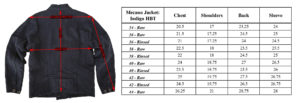 Mecano indigo HBT  Mecano 401 Denim CARE:
Launder when needed.
We recommend turning indigo blue/denim garments inside out to avoid marbling during laundering. Machine wash, cold water, gentle cycle, eco-friendly mild detergent and line dry.
Potential attractive patina will develop according to activities and frequency of wear.
Please note that dark indigo might cause color transfer, and potentially “bleed” on light-colored garments, furniture, and skin.
Available Sizes:
34 (X-Small)
36 (Small)
38 (Medium)
40 (Large)
42 (XLarge)
44 (XXLarge)
Available from www.misterfreedom.com, our Los Angeles brick & mortar store, and fine retailers around the World.
Email sales@misterfreedom.com or call 323-653-2014 with any questions unanswered above.
Thank you for your support.
Christophe Loiron
Mister Freedom®
©2019

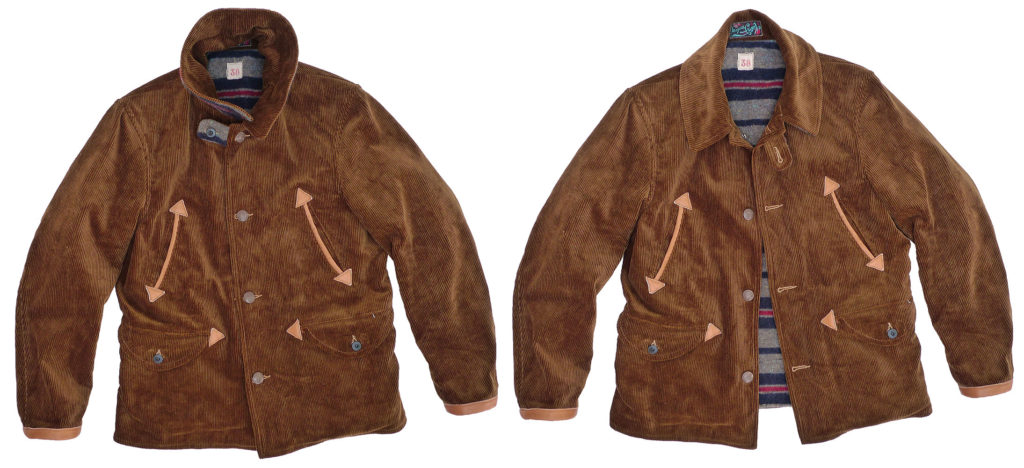

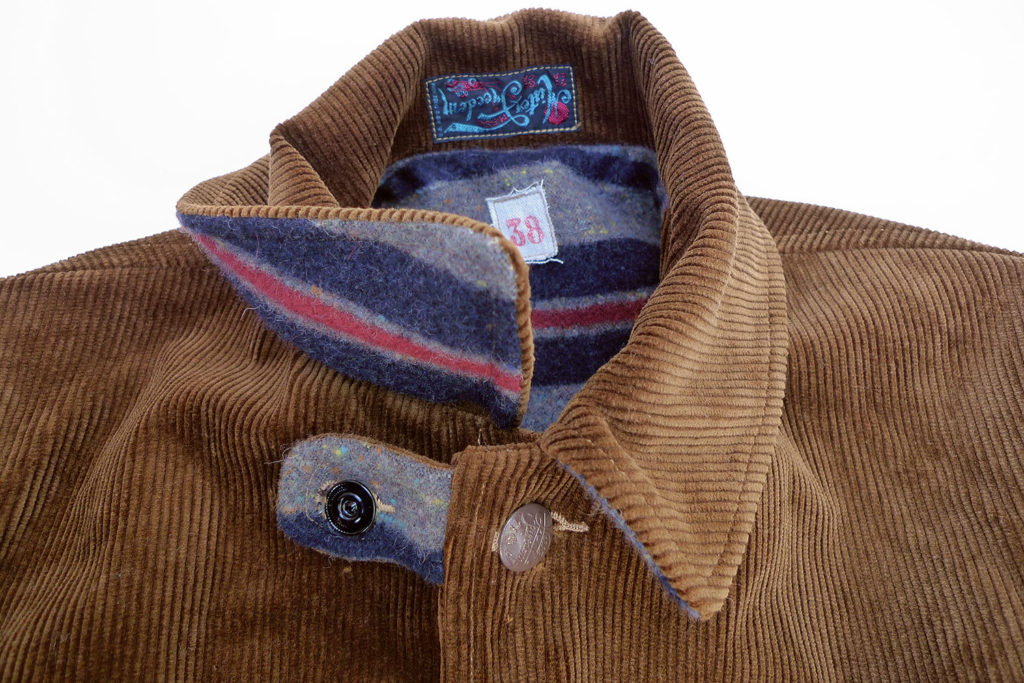
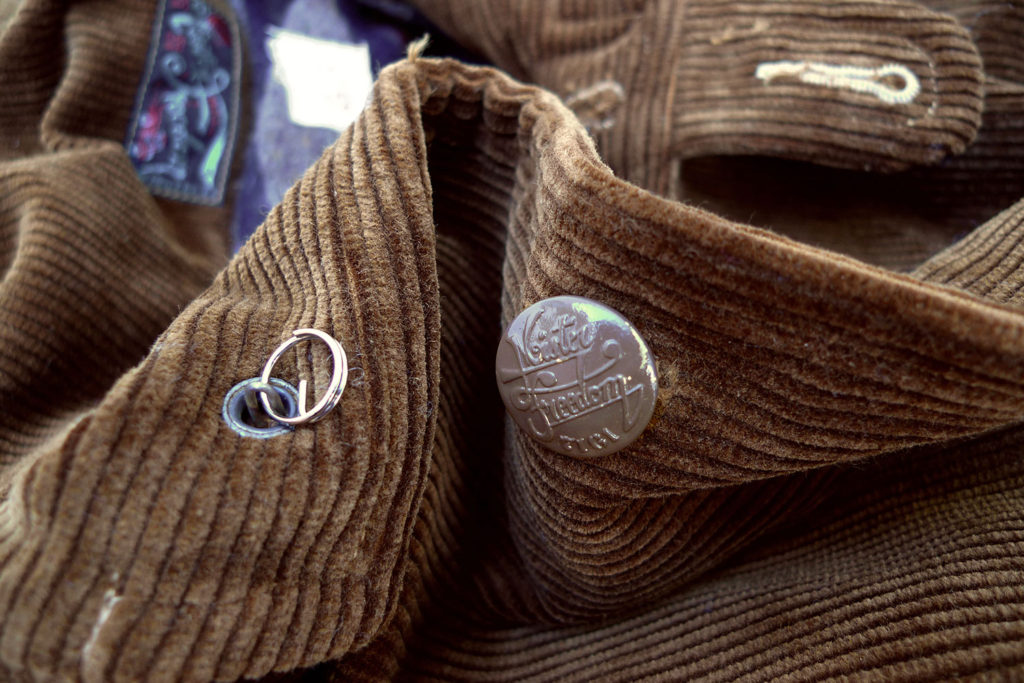
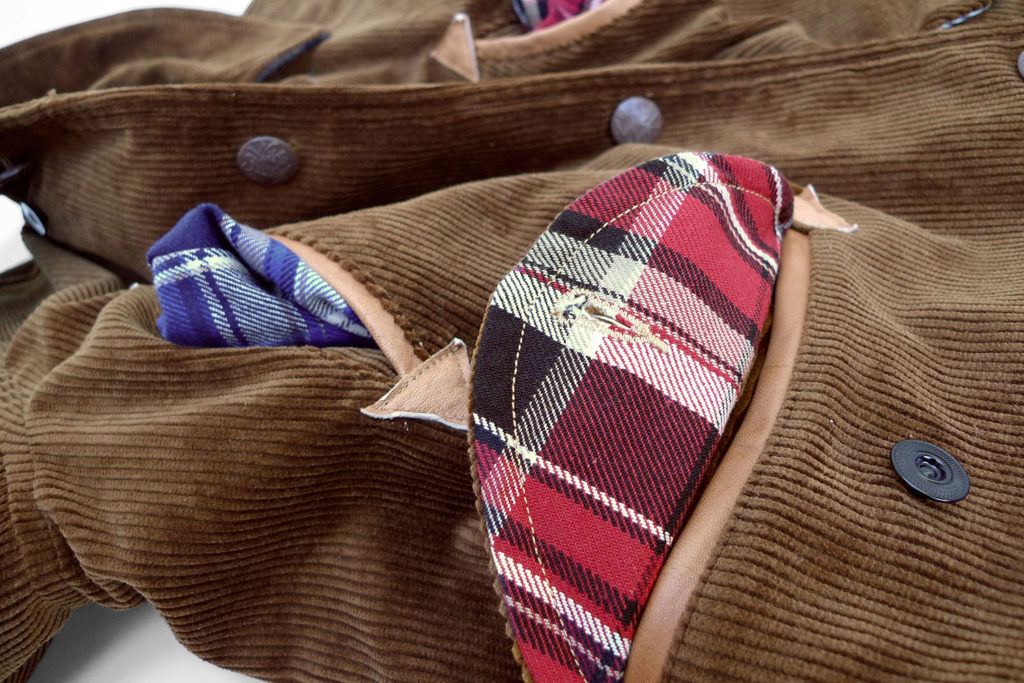
Mister Freedom® “MATTOCK” Jacket, 14 Oz. corduroy.
FW2019 mfsc Surplus catalog.
Made in Japan.
The MF® MATTOCK jacket got its moniker from the classic vintage mackinaw coat that inspired our original design. The inspirational piece, an old 1940’s wool plaid jacket, bore two labels. One barely-readable, featuring what looks like the familiar white sheep trademark of its maker, WOOLRICH®, and one sewn-on by the original owner, a certain Ray Mattock.

Our ‘interpretation’ ended-up having very little in common with the vintage red/black buffalo plaid garment, so we just kept half the name.
For those inclined, what follows are the usual ramblings about the design process, and how we turned a classic piece of Americana into a jambalaya of Old and New World à la MF®.
The Mattock features details inspired by early American and French workwear/outdoor jackets, blended into a classic mfsc vintage “might have been.” On that note, should our Mattock pop-up in the collection of an inspired contemporary fashion label next season, as “designers” sometimes assume we simply lift patterns verbatim from vintage garment, we would of feel nothing short of tremendously flattered.
The shell fabric we opted for is reminiscent of vintage “Velour d’Amiens”, a type of heavy wide-wale cotton corduroy that the connoisseur of old 1930’s~40’s French outdoor/work/hunting garments will be familiar with.
Sadly, the grade of high-quality sturdy corduroy that originated in Amiens, France, sometime in the 18th Century, is no longer being manufactured. Cosserat, a textile mill founded around 1793 and one of the last velour côtelé manufacturer from Amiens, permanently closed its doors in 2012. After several restructuring attempts, and with low-cost corduroy manufacturing coming out of China flooding the market, management of the long-standing Coserrat mill eventually gave up. Another collateral damage of the average consumers’ addiction to a plethora of cheap disposable garments rather than a curated and durable wardrobe.
For this project, our friends at Toyo Enterprise sourced a cord fabric that is somewhat reminiscent in texture of traditional Amiens workwear corduroy. We opted for a rich camel brown color, expertly matched by a Japanese dyehouse to the specific shade of brown of a 1930’s vintage French hunting coat from our archives.
The French vibe was then “americanized” by lining our jacket with a striped “Troy” blanket, sometimes referred to as “Alaska” blanket.
The choice of removable “shank” (or “ring”) buttons, is a nod to the original mfsc front closure of our McKarsten jacket. Instead of stitched eyelets, we went for metal grommets, a feature that I have personally never seen on vintage jackets but probably already exists.
We worked out a chin strap in the top closure, played with facing and lining on the collar, threw in some attractive patina-prone leather trim accents, and spiced-up the jambalaya with mismatched pocket lining. We used Sugar Cane Co vintage replica woven plaids, left-over yardage from recent heavy cotton flannel Toyo production. This concealed feature is sometimes seen on vintage pieces, when linings and pocketing could be cut from whatever surplus fabric was on hand, to save on production costs and delays.
Time to end this novel by mentioning that the upside-down neck labeling featured on above product photos was the funny blooper of an early prototype. Production differs, unless you get lucky and score a rare and collectible UFO that eluded QC.
The MF® Mattock Jacket is designed in California by Mister Freedom® and manufactured in Japan by Sugar Cane Co.
SPECS:
PATTERN:
An original mfsc pattern inspired by 1930’s~1940’s mackinaw jackets and vintage outdoor coats, blending New World and Old World flavors.
FABRIC
Shell: 14 Oz. Heavy wide-wale corduroy, 100% cotton, milled in Japan.
Lining: Soft-hand “Troy Blanket” wool blend fabric, 60% re-used wool, 28% cotton, 12% rayon). Woven in Japan.
DETAILS:
- All original mfsc pattern.
- Full “Troy” recycled wool blend blanket lining.
- Leather trim accents on pockets and cuffs.
- Four pocket front, hand warmer and flap slash pockets combo.
- Pocket linings cut from mismatched vintage-style cotton woven plaid heavy flannel.
- Original mfsc removable painted brass “shank” buttons.
- Rear cinch tabs.
- Chin strap.
- Original mfsc “Surplus” rayon woven label.
- Made in Japan.
SIZING/FIT:
The MF® MATTOCK Jacket comes raw/un-rinsed, and can be worn as-is as it is true-to-size and does not need to shrink to fit.
For a subtle puckering of the stitching and fabric torque, with minor to unnoticeable shrinkage, the jacket can be cold soaked for 30mn, spun dry and line dried.
Do not use a full washing cycle or heat dryer.
I wear size 38 in most mfsc jackets and opted for a size 38 in the Mattock, for a trim yet comfortable fit. Refer to sizing chart for raw measurements, with our measuring method explained here.
To figure out which size will best work for you, a good system is to compare our measurements with those of a similar, lined, ¾ length jacket you own and that fits you well.
CHART
CARE:
Professional dry cleaning recommended, at an eco-friendly facility familiar with leather-trimmed garments.
This is quite a heavy jacket that might get damaged if laundered in a home washing machine.
Remove all shank buttons before cleaning.
Available Sizes:
36 (Small)
38 (Medium)
40 (Large)
42 (XLarge)
44 (XXLarge)
Available from www.misterfreedom.com, our Los Angeles brick & mortar store, and fine retailers around the World.
Email sales@misterfreedom.com or call 323-653-2014 with any questions unanswered above.
Thank you for your support.
Christophe Loiron
Mister Freedom®
©2019
|
















